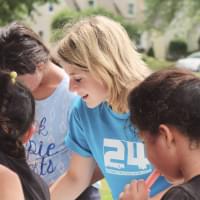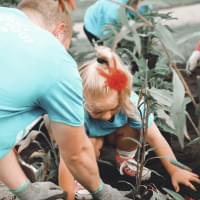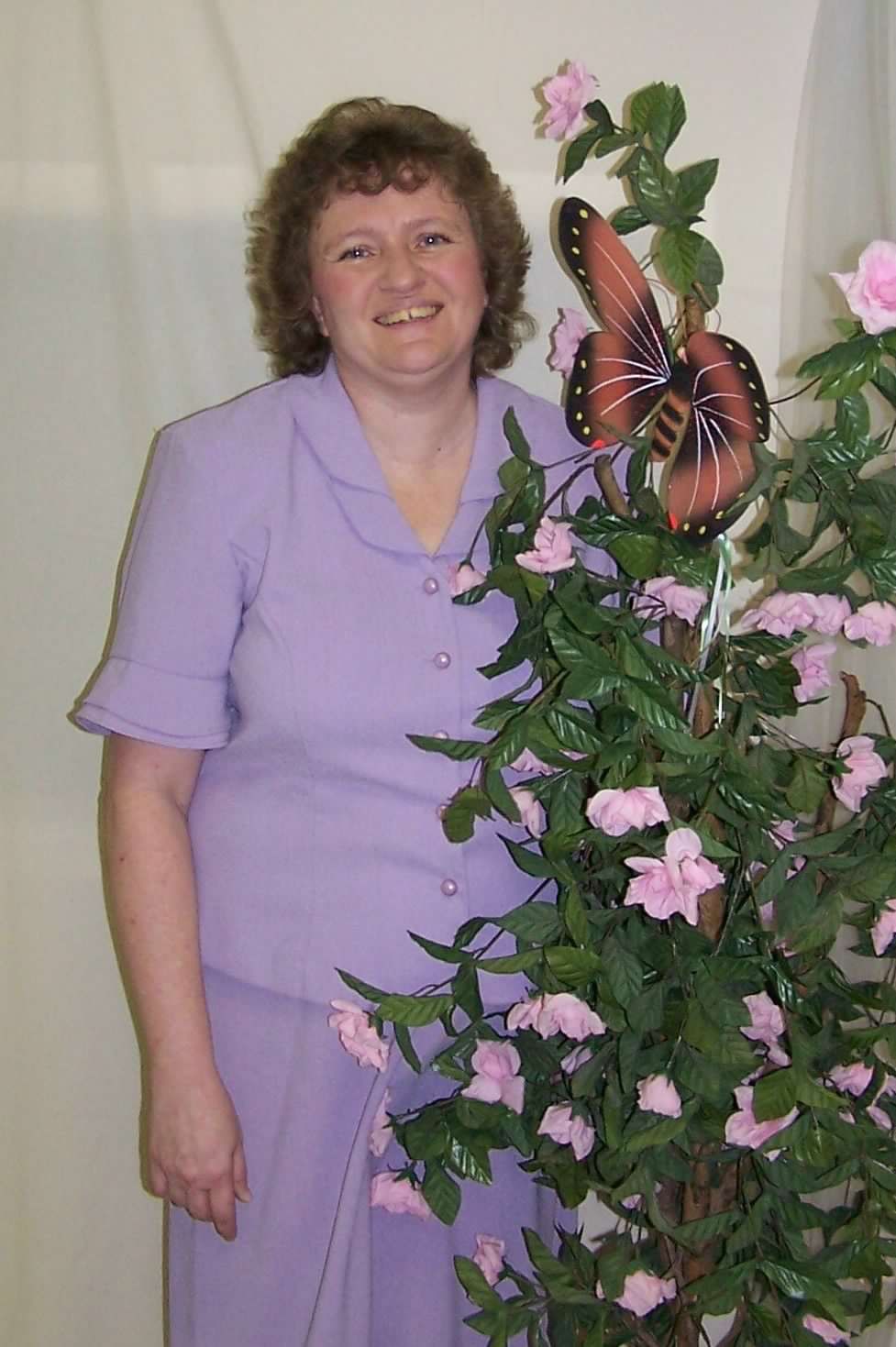
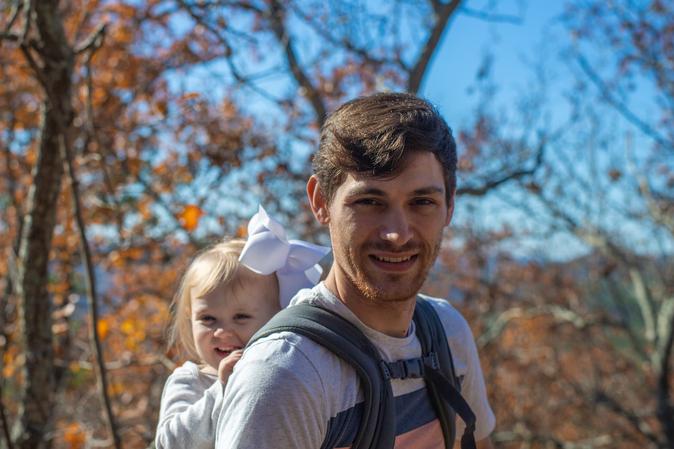
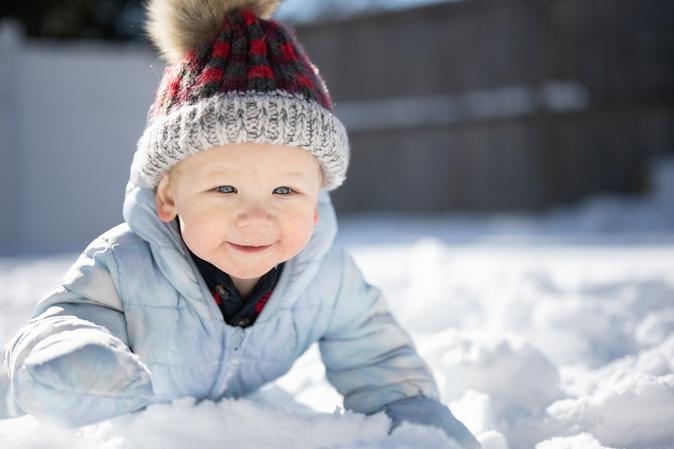
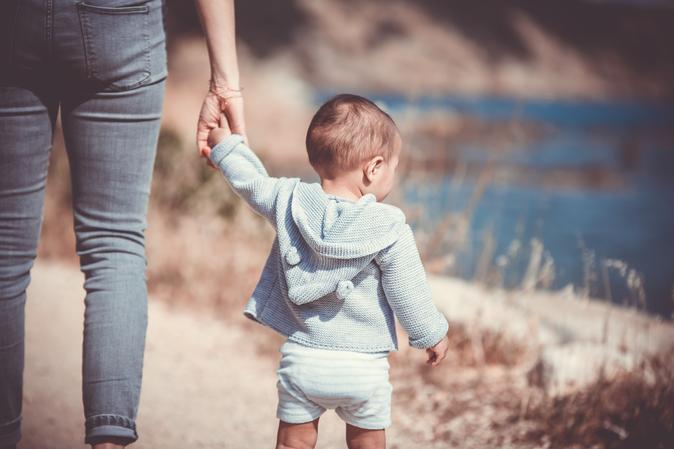
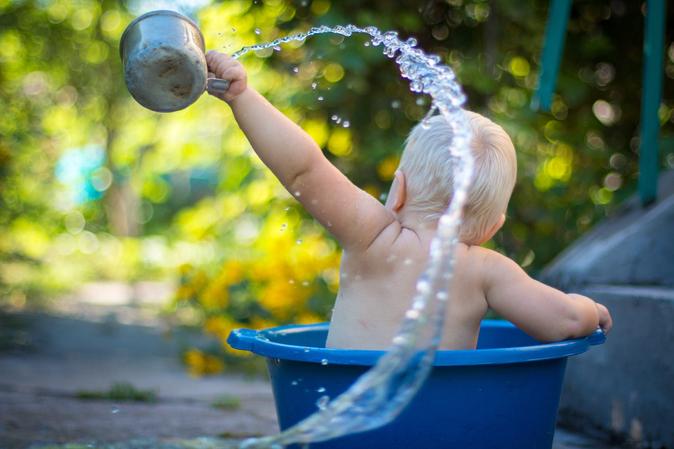
Superscript
Everyday Sunshine and Fun
Infants and toddlers benefit from access to a wide variety of sensory stimuli outdoors. In other words, babies learn outdoors in ways they can’t indoors. So keep your outdoorsy lifestyle. With alittle ingenuity, you can share everything you love about being outside with them. And they will find thier own treasures and interests outside as well.
♥
Our Series for Babies And Tots
Exploring The World
Exploring The World
Advance Directly to Section For Itty Bitty Babys
Advance To Taking Your Favorite Inside Activities Outdoors
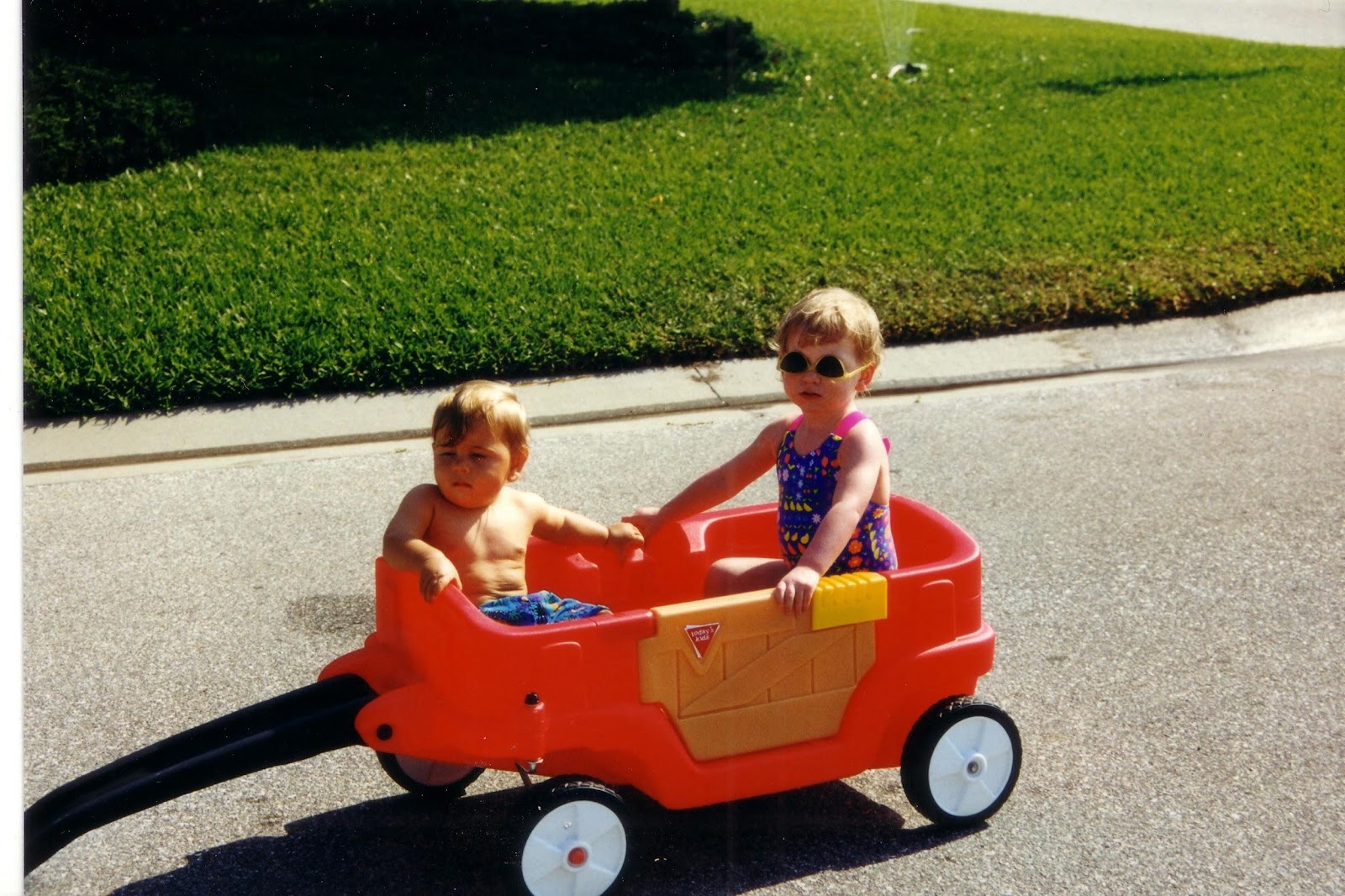
Most afternoons, when the clock would strike four, our children would instantly be reminded that it was time to get fussy, irritable, and even refuse to nap when they clearly needed it most. Thankfully, there were a few activities always seemed to calm them down. The first was taking a ride in the car. Although there was usually some crying over the car seat, they always seemed to calm down after a few minutes. The second was taking a walk outdoors.
As we would step outside, they would go from angry to enchanted when their senses were hit with all the beautiful colors, smells, sounds and the cool breeze. It was clear to me that getting a little fresh air wasn’t just good for adults. Science actually backs up these benefits, especially for babies and young children.
A European study published in 2014 found that babies and children who spent more time outdoors actually received a jumpstart on language skills and physical development. From the wind to sunshine to smells both good and bad, babies simply have more sensory information to take in and process outside than when they are in a controlled, indoor environment. That, in turn, promotes early development as babies start to process what contributes to that outdoor stimuli. The physical development of babies has also been proven to benefit from time spent outdoors, especially for those who often observe others running around and playing — proof that those park trips before baby can even walk are still important.
Regular bouts of time in the natural sunlight can also aid the establishment of good sleep patterns for little ones. According to a 2004 study in the Journal of Sleep Research, babies younger than 13 weeks who slept well at night spent twice as much time in the sunlight as their wakeful peers. The lead researcher hypothesized that’s because the outdoorsy infants established their circadian rhythms sooner, helping them fall asleep sooner and stay asleep longer.
As important as it seems to be to get babies outdoors, there are still some precautions parents can take to keep young children safe and healthy.
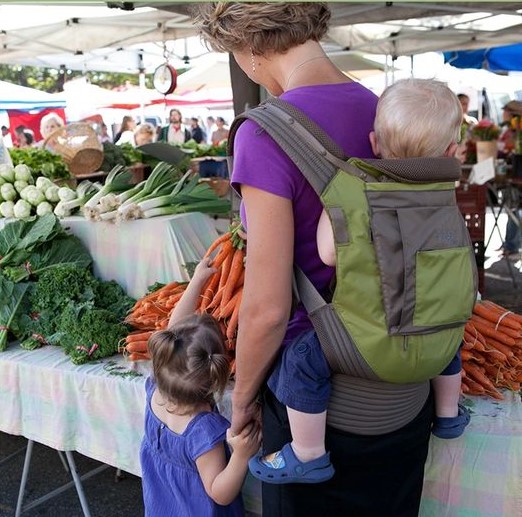
Avoid large crowds at first
While it’s fine to go out in the yard or to a quiet park, you’ll want to try your best to avoid places where there are crowds for the first several weeks of your baby’s life. The younger she is, the more immature her immune system, and the more susceptible she is to pick up germs from other people and nearby coughs, sneezes and unclean hands. Once your baby reaches 2 to 3 months, her immune system will mature significantly and you won’t need to be as concerned.
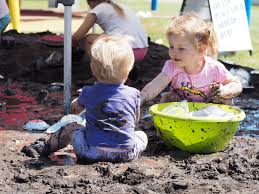
Dress for the weather
Before you head out and about, you might be tempted to bundle your baby up in extra layers, or if it’s summertime, to put him in a stroller in just his diaper. The general rule of thumb is to dress your baby for the weather—not too hot and not too cold—and add an additional layer.
Wash Hands
When you get home from an outing, be sure to wash your newborn’s hands, especially if anyone has touched her. It would also be a great idea to wash your own hands, to avoid transferring anything from yourself to the baby. If health and safety concerns still give pause, rest assured that pediatricians agree most newborns can benefit from time outside.
The key is to take a few precautions for young outdoor adventurers, including staying out of direct
sunlight, dressing in appropriate layers and avoiding places where people are known to be ill.


Superscript
Try doing your favorite INDOOR things outside
We can take a fussy baby outdoors they calm down immediately. And cranky kids can cut loose and be as loud as they want to under an open sky. Why would anyone want to spend their entire day inside enslavened by their cell phones and televisions?
SO...GO OUTSIDE AND EXPLORE !!!
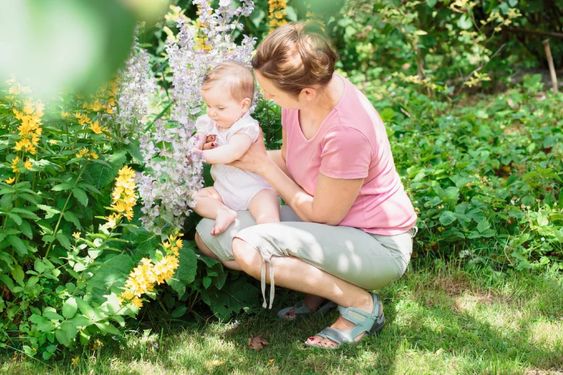
THE AMAZING BENEFITS OF BEING OUTSIDE FOR BABIES AND TODDLERS MOTIVATED ME
Have you ever brought your baby outside and noticed that they come alive as the wind ruffles their hair and sunbeams dance on their face? Maybe there is something about the limitless sky or the endless discoveries to be made. And, it turns out that beyond these sensory delights, there are scientific advantages to exposing your wee one to the great outdoors. Here are seven fantastic benefits of getting your baby outside.
Outdoor play can make THEM happier.
Endorphins are chemical messengers from the brain that can do magical things like manage pain and even bring pleasure. As your blood and lungs pump during exercise, your brain releases endorphins and makes you happy. Grown-ups might know the feeling of a "runner's high." And kids might know this feeling as the pure joy sparked by frolicking outside. Allow your baby to roll around on a blanket in the grass or practice those first steps at the park, and they might just be able to bask in those blissful brain chemicals, too.
Spending time outside helps foster a love of nature.
If you give your baby lots of opportunities to commune with nature, then they might grow up to be a nature lover! Taking daily walks and talking about how much you love the sunshine, the singing birds, the feel of the air, or pointing out plants, bugs, and critters can ignite your child’s curiosity and appreciation for the great outdoors. Playing in nature can help children of all ages with their motor skills, communication, social-emotional skills, sensory integration, and so much more!
Newborns who spend time outside sleep better at night.
In a 2004 study, researchers found that babies who spent time outside in the sun slept better than babies who did not spend time outside. The results indicated that natural light affects a baby's circadian rhythms, and exposure to early afternoon sunlight helped their brains better identify when they should sleep and when they should wake.
EXPLORING Promotes Early Language Development:
The outdoors helps babies to learn. When infants and toddlers are exposed to rich sensory environments their minds are active. When you bring a baby outside and begin pointing out all the wonderful things they can see, hear, touch, smell, and even taste (hello, rain!) then you are giving your child a robust learning experience that can build their vocabulary and fire up their imagination. One fun activity is to give your baby a tour of one particular sense, like smell or sight, and point out all of the things they can experience with that sense. Nature provides an abundance of sensory experiences which in turn activates the intake of the child’s mind. Babies become more curious and this combination encourages early language development.
EXPLORING Helps them Make sense of the world:
Inviting infants and toddlers to explore nature coincides with their natural instincts to become scientists and explorers. These explorations build a foundation for their learning. Nature exploration develops the formation of babies’ synapses while they are trying to make sense of the world. If you give your baby lots of opportunities to commune with nature, then they might grow up to be a nature lover! Taking daily walks and talking about how much you love the sunshine, the singing birds, the feel of the air, or pointing out plants, bugs, and critters can ignite your child’s curiosity and appreciation for the great outdoors.
Good for the entire family
Infants and toddlers sense the stress of their caregivers. Exploring nature together is an ideal activity, as getting outdoors can decrease depression, anxiety, and tension in adults. Outdoor play can make you happier. Endorphins are chemical messengers from the brain that can do magical things like manage pain and even bring pleasure. As your blood and lungs pump during exercise, your brain releases endorphins and makes you happy. Grown-ups might know the feeling of a "runner's high." And kids might know this feeling as the pure joy sparked by frolicking outside. Allow your baby to roll around on a blanket in the grass or practice those first steps at the park, and they might just be able to bask in those blissful brain chemicals, too.
Advance Directly to Section For Itty Bitty Babys
Our Series for Babies And Tots Exploring The World
OUTDOOR ACTIVITIES FOR INFANTS
UP TO 1-YEAR-OLD
It’s easy to explore nature with infants. Get them into some appropriate clothing for the weather, and head out the door. Nature is a perfectly balanced sensory experience for children. They’ll be able to take in the muted colours and natural sounds without feeling overwhelmed. If you’re holding them against you for these experiences, then all the better as they are also being comforted and connected to you at the same time.
So, my guess is you will go with your preference as to where your baby will spend the bulk of their time irregardless of anything I can say. But I will tell you that your baby benifits greatly from the fresh air and sunshine. (arrow down to article on the benifits of your baby being outside)
Most anything that you do inside, you also can do outside for the morning and give them what they need. So I am going to give you suggestions for infant develpment that are universal to either environment. The choice is your to make on the setting.
In the first 3 months of life, babies are simply processing and sizing up the world around them. So fill that time with things that you want to share with them. They are literally like sponges absorbing and taking in sensory data that we provide for them. That is how they are learning.
However, don't confuse the inability to react, with the ability to learn. So read to them, sing to them, and narrate your activities in a way that is comforting to them.
Introduce them the people, places and things that will be important in their lives so they build a bond and feel secure in those situations. Challenge them learn and explore with all their senses and discover all the delights of our world so they become curious little beings. And most of all snuggle and hang out with them every moment that you can so you learn what things make them happy, sad, cry, smile etc. I am sure that you will want to be at their side whenever they are experienceing something new so they learn to depend on you.
For infants, the actual activity really isn’t as important as just giving your baby new experiences. These activities for infants are all simple, quick and easy and should be able to easily incorporated into your daily flow. Being outside with a newborn is so much fun. Everything is new for them to experience and you can help them develop their vision, hearing, touching, and smelling through exploring through all those senses. For infants, the actual activity really isn’t as important as just giving your baby new experiences. These activities for infants are all simple, quick and easy and should be able to easily incorporated into your routine.
Babies are naturally curious about everything in their surroundings, and you may well find that they are drawn to the strangest objects. Also, they may start to show that they have some favorite objects.
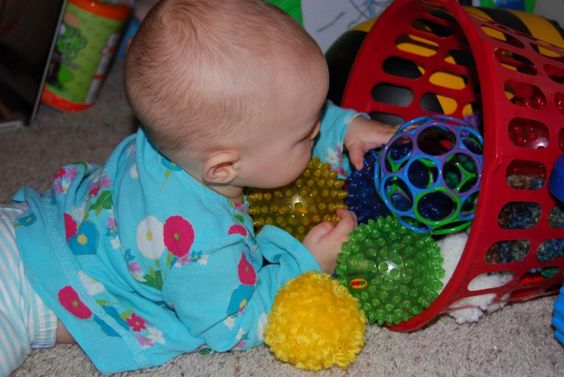
From birth, introduce lots of tummy time using a variety of textured materials, scarves and mirrors. Tummy time is important for the physical development of the body. This sows the seeds for developing our core muscles needed for fine and gross motor skills. It also begins the process of bodily development that will later result in body posture, and even toilet training.
Provide lots of items to develop hand eye coordination:
Scarves and ribbons
Bright colored hair scrunchies
Sensory balls-several sizes with differing textures
Soft hand mitts
Curtain rings
Homemade sensory bottles
Textured materials
Board books
Hair rollers
Nature's Treasures- loose parts of a safe size
Interesting kitchen utensils
At around 3 months they will start reaching and grasping. I love baby animal toys, rattles, soft blocks, figurines etc., so I start there. You should look You will start to see some interest in grasping toys. She won’t be very effective at grasping yet but her attempts to secure objects will strengthen her hand and finger muscles, improve her coordination, and capture her attention.
From Reflexive to Purposeful Movement
This isn't your baby's first experience with grasping, she was born with a grasping reflex - the same one that makes for adorable newborn photos of a tiny hand wrapped around a parent's finger.
Most of baby's very earliest movements are driven by reflexes. Through opportunities to explore how her body moves and to "play" with people and objects, your baby's reflexes will begin to integrate, or disappear. This paves the way for intentional or purposeful movements - like grasping toys - to emerge.
Helping Baby Play Through Early Grasping
As she’s learning to grasp, your baby will be most successful with lightweight toys that can be secured with lots of different hand and finger positions. She won't have established grasping motor patterns (or set plans for how to shape and move her hands and fingers to grasp different objects) yet. All of her grasping will be trial and error at this point.
By placing objects in a basket or small shallow pan, you allow baby to push and bump her hands up against items while keeping them close. She can also use the wall of the container to help her grasp the items.
Given simple, quiet grasping activities, you'll be amazed at how focused and intent your little one can be for several minutes at a time. There isn't a need or benefit to loud, battery-operated toys or those that are extremely visually busy. Your kiddo's brain is wired to focus, persist through several rounds of trial and error and to find successfully grasping rewarding without bells and whistles. I advocate for simple grasping toys that introduce them to things in nature.
Cut paper towel or toilet paper tubes make great early grasping toys. Cut them into rings about 1-2” wide and place them in a low basket or pan. Ribbon strips are easy grasping toys (with close supervision, of course - eyes on baby within arm's reach). Golf balls make a great noise when placed in a metal pan and pushed around during grasping attempts. Your baby is too young for ring stacker or shape sorter toys but you can place the pieces from those toys in a grabbing basket.
POSITIONING BABY FOR GRASPING PLAY
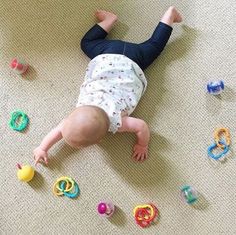
Tummy Time Grasping Play
Because grasping typically emerges before baby is strong enough to prop on one arm and reach in Tummy Time, it's helpful to prop baby on your lap or over a Tummy Time pillow with hands free to play.
She'll still get the back and neck strengthening benefits of Tummy Time, the sensory experience to her positional/movement sense (vestibular sense) and her pressure & stretch sense (proprioceptive sense), as well as a break from pressure across the back of her head (which helps to prevent Flat Head Syndrome or Positional Plagiocephaly).
Seated Grasping Play
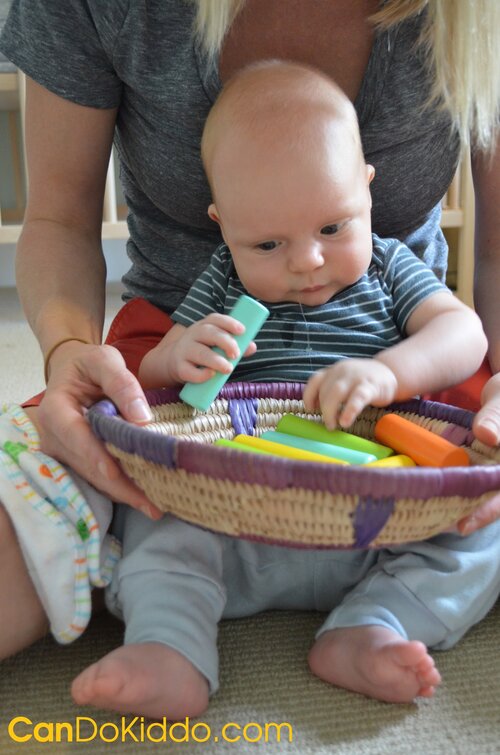
If your baby is showing some ability to sit with support, you can hold her in a seated position for brief periods of seated grasping play. Holding your baby in supported sitting is preferable to putting her in a Bumbo or other seat because it offers dynamic, responsive support that adjusts to her body positions and needs.
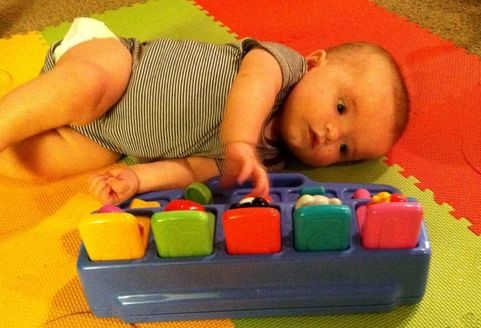
Sidelying Reaching Play
Baby laying on her side is a great position for reaching play because it encourages her two hands to come together at midline - the center of her body. Midline and two-handed play promotes brain development by stimulating the two sides, or hemispheres, of the brain to communicate and coordinate. You can use a rolled towel or bag of rice behind her back to support baby in this position if she rolls easily out of it.
By allowing your baby opportunities to practice the emerging skill of grasping, you support her natural development. By giving her playtime in a variety of positions, unrestricted by Baby Holding Devices, you promote her healthy and prevent conditions such as Flat Head Syndrome and Torticollis. By understanding her development, you learn to enjoy watching and encouraging the most subtle changes she's making - a newfound interest in toys, opening and closing of her fingers, beginning to use her eyes and hands together to reach for objects. The early months are exhausting and challenging for new parents, why not add some fun into your days?!
Tummy time with a boppy
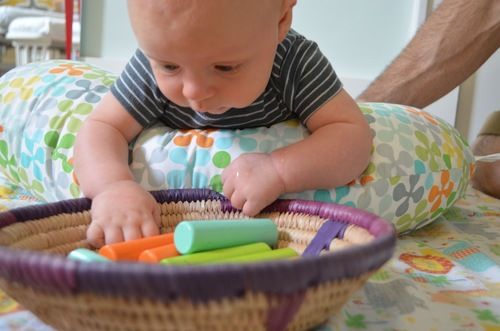
Using a Boppy for Tummy Time puts your baby at an incline (shoulders and head higher than hips) - making it a bit easier to lift and hold the head up for extended periods. It also changes your baby's line of sight so that he can see more of his surroundings. Plus, one of my favorite features is that it allows baby to reach, touch and grasp before he's able to shift all of his weight to one arm in order to free the other one for these tasks.
All things in moderation...
It's important to remember that one of the many benefits of Tummy Time is upper body strengthening through weight-bearing on the arms. With that in mind, you won't want ALL of your baby's Tummy Time to take place over a Boppy or Tummy Time pillow. But it's a nice way to add variety to belly-down play, still accomplishes many of the benefits of Tummy Time and is a great alternative to parking baby in baby gear during awake time.
By aiming to give your baby at least 60 minutes of Tummy Time by the end of month 2 and 90 minutes per day by the end of month 3, you'll have plenty of opportunity to do Tummy Time in a variety of places - on a Boppy, on a firm surface, on a parent or caregivers lap or chest (laying down), held belly-down on an adult's forearm, etc.
10 Boppy Pillow Tummy Time Play Ideas
Most Tummy Time activities can be modified for using a Boppy Pillow. Here are some creative activities that you might not find elsewhere to make Tummy Time a time for play, exploration and discovery:
Float a Bath Toy In a Pan of Water
Sensory Bags Taped to the Floor
Grasping Baskets with easy-to-hold toys
Look at an Accordion-Style Book
CREATING A LOOSE PARTS SENSORY BASKET
FOR BABY PLAYTIME
FOR BABY PLAYTIME
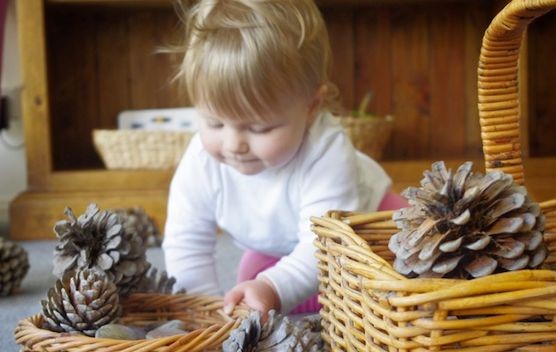
As a mom with tons of teaching experience and a Bachelor’s and Master’s degree in Education, I want to show you how you can easily bring loose parts and sensory play into your home.
When Brandon was about 7 months old I noticed he was tired of a lot of his toys. I found I had a hard time encouraging him to play independently as nothing could keep his attention for more than a minute or two. I suspected it may be time to introduce loose parts sensory play and was delighted to see that he was absolutely fascinated by the objects I presented him with. So, I did what any mom who’s a former educator would do. I poked around the yard and picked up a few things from nature, rooted through our recycling bin, and emptied the kitchen drawer.
I decided to create a loose parts basket I could keep on hand and fill with interesting objects Brandon could explore time and time again. Since I wanted my measuring spoons back in the kitchen where I could use them, we hoofed it over to the dollar store with the intention of collecting designated items for a loose parts for a sensory play basket.
I first introduced loose parts to my son Brandon at 7 months old and in hindsight, probably could have done so at an earlier age. At over 10 months, he’s still happy to play independently with items from his loose parts sensory basket, such as these silicone hot plate holders.
Now, you may be saying “you did what? Collected outdoor loose parts?
What does sensory play mean?” If this is the case I don’t blame you. There are so many articles and boards out there confusing us all with their early childhood education scholarly speak.
Creating a loose parts sensory basket saves time, space, and valuable parental energy. I want to make this information accessible and easy to understand because it’s one of the best learning opportunities you can offer to your baby. Let’s break this down in the simplest way possible so you can get started with some loose parts sensory fun with your kiddo.
Creating a loose parts sensory basket saves time, space, and valuable parental energy. Engaging your baby in sensory play doesn’t have to be an elaborate activity. Creating a basket of loose parts for baby to explore makes interesting objects easily accessible.
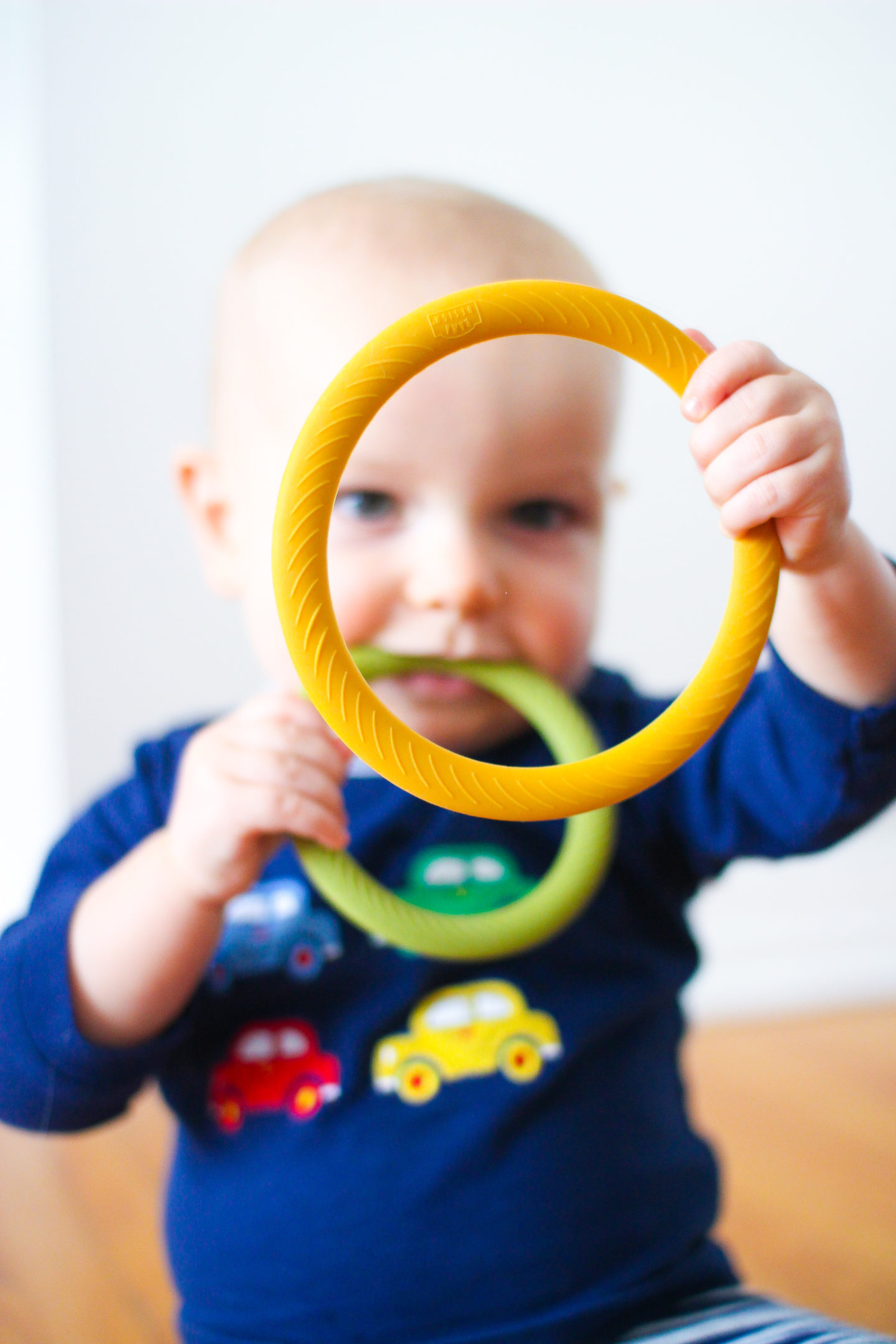
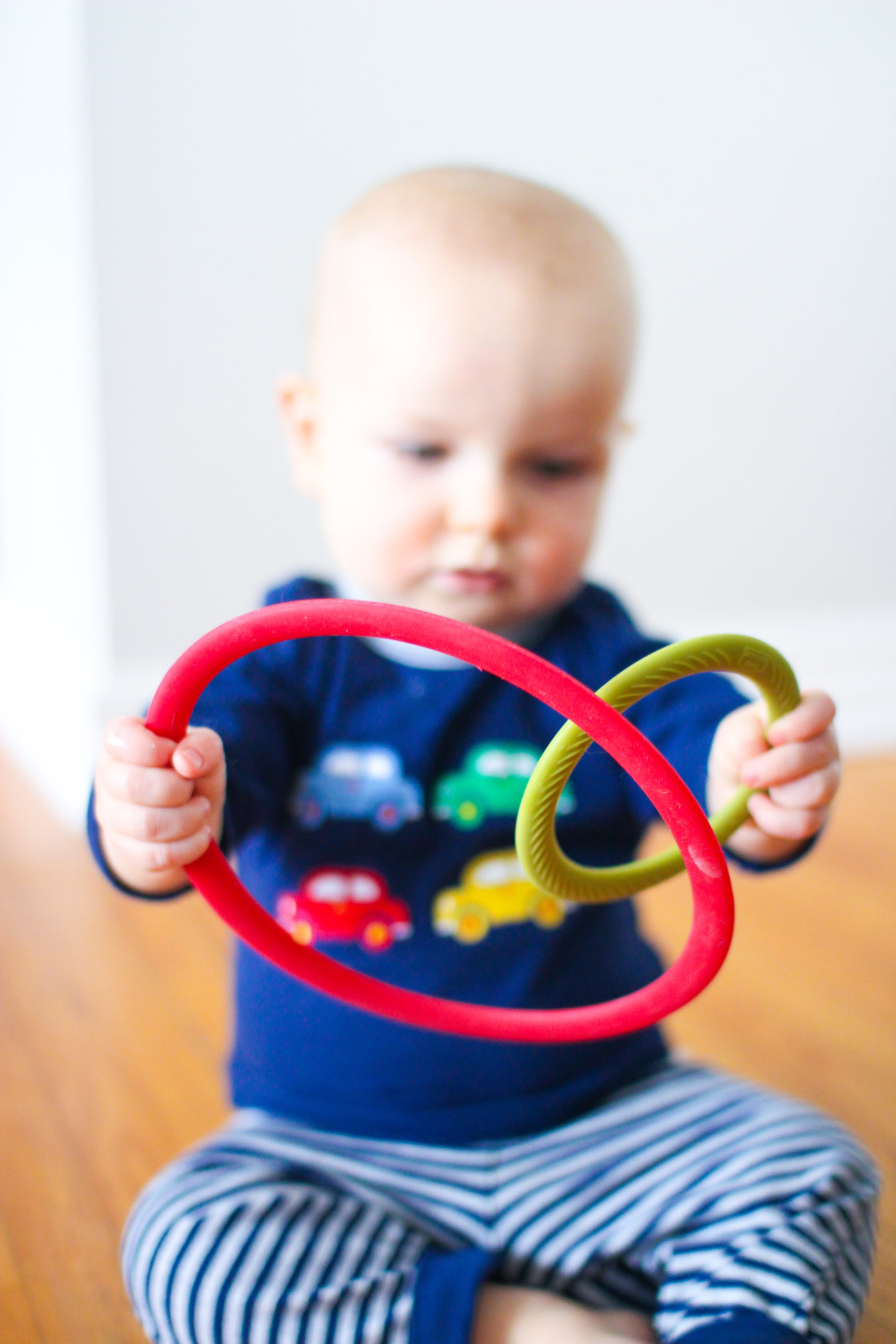
WHAT IS SENSORY AND LOOSE PARTS PLAY?
I have read so many articles over the years that complicate the concept of sensory and loose parts play to no end. So plainly speaking, what is it?
Sensory play is meant to excite the senses (sounds fairly obvious, doesn’t it). This includes activities and objects that will stimulate baby’s sense of hearing, touch, smell, and taste. Learning that stimulates baby’s sense of hearing, touch, smell, and taste. As humans, we retain information more efficiently when we engage with several of our senses in any experiece.
Sensory play helps the brain create strong connections through problem-solving and exploration.
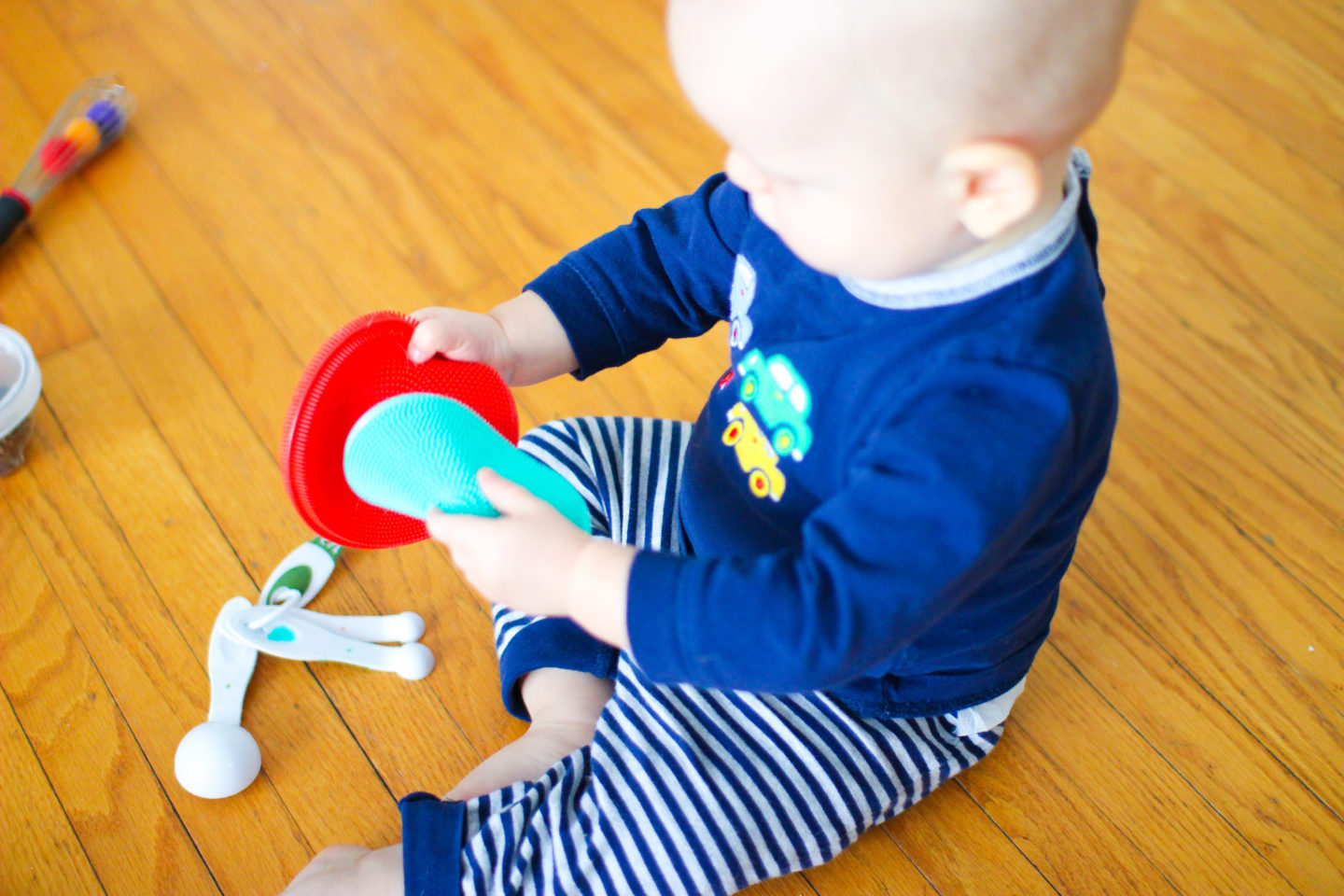
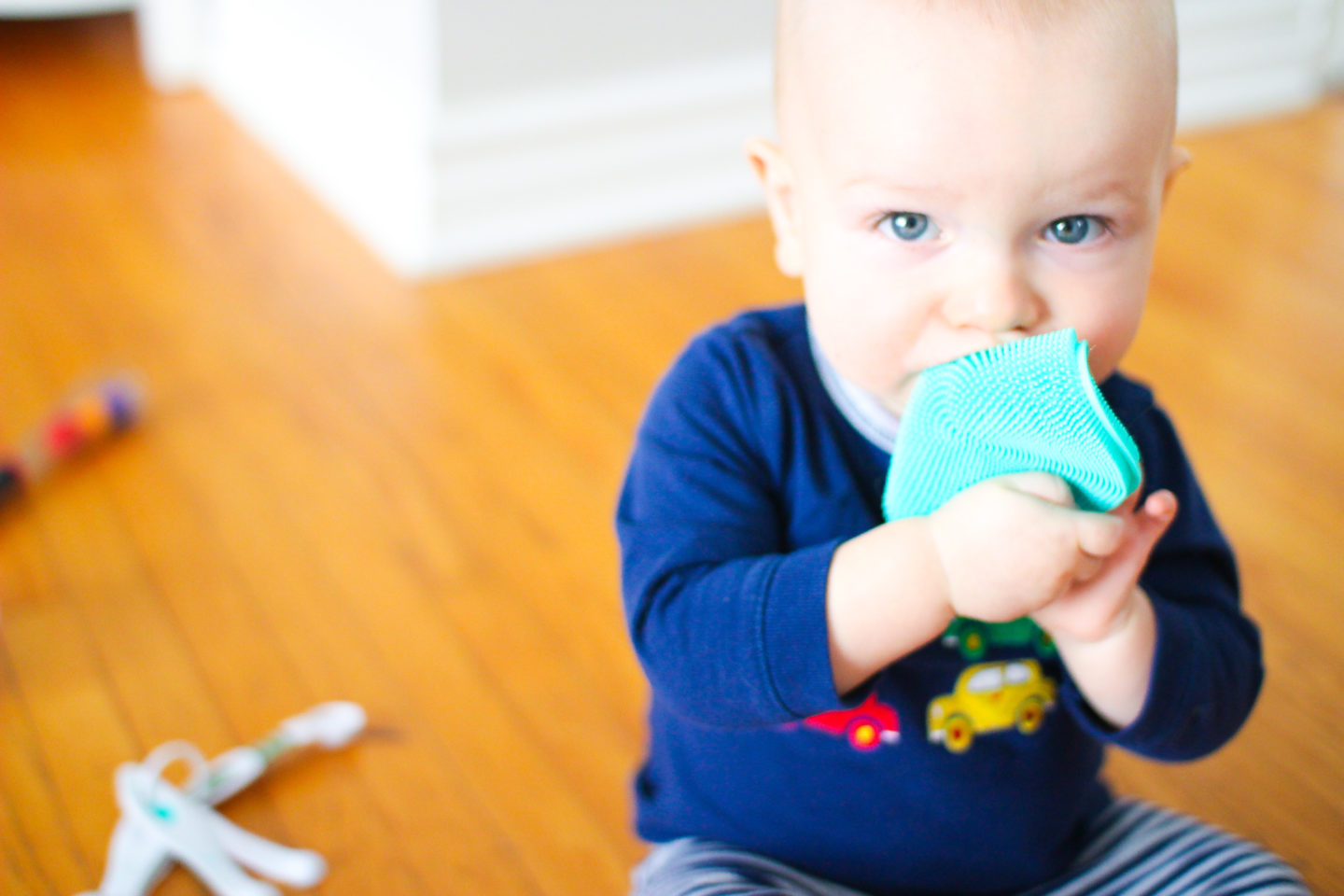
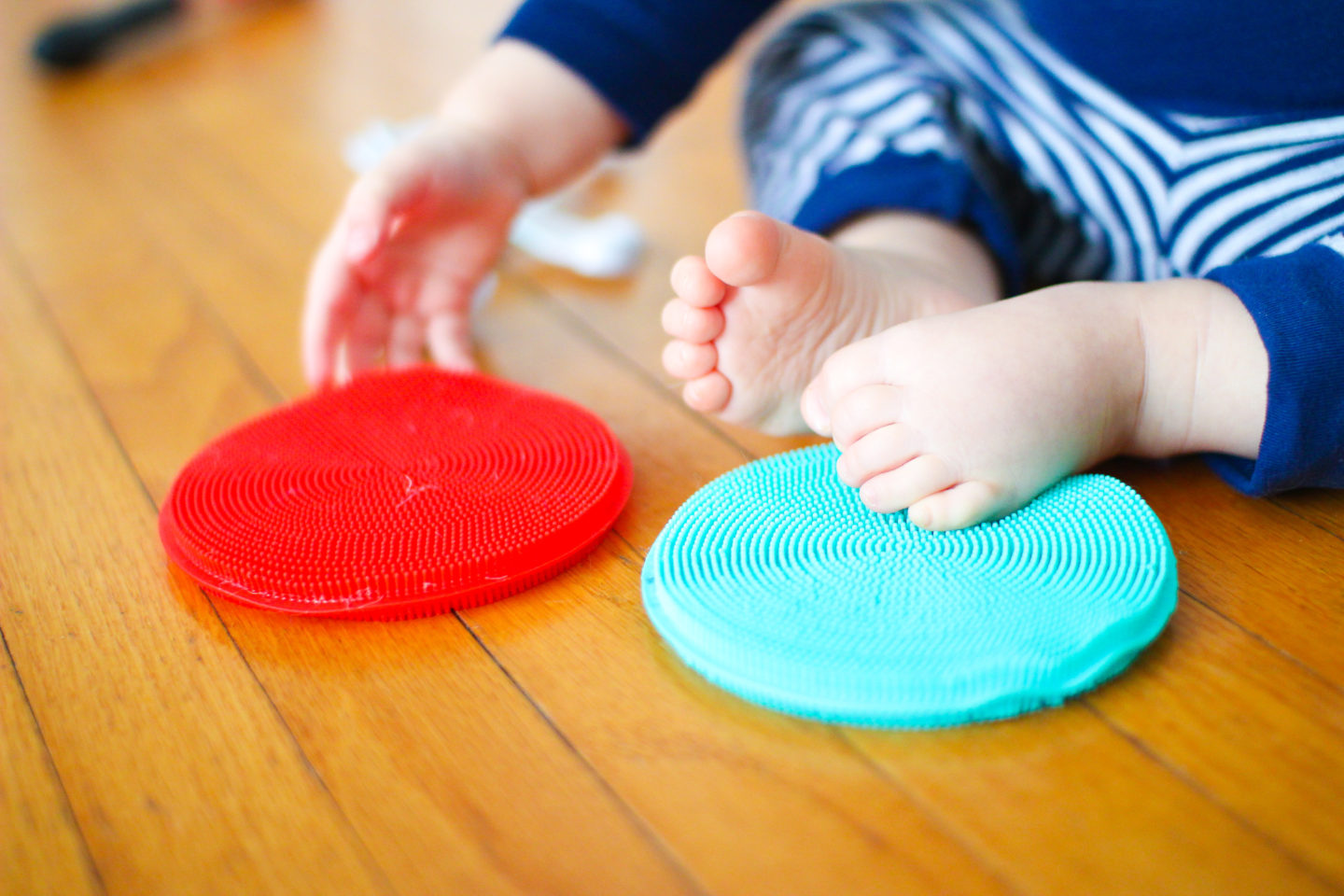
The entire point of introducing sensory activities to baby is to stimulate their senses while also providing opportunities for open-ended learning (so they’re busy with something for a while and you’re able to finish your cup of coffee, you feel me?).
I see all kinds of sensory play activities online, but they’re one-offs, or they’re something the child will explore for an afternoon before you clean it up and put it away. This is why I like to create sensory play activities using loose parts and have a designated basket to house the items, for repeated use.
I’m purposefully not referring to these items as toys because they’re not. Loose parts aren’t toys, they’re things. This kind of play provides baby with opportunities to mouth, touch, bang together, manipulate, observe, and rearrange objects.
Loose parts aren’t toys, they’re things. They’re items from nature, stuff you have lying around the house, and even things from the recycling bin. Metal bowls, silicone pot holders, a plastic water bottle filled with beans, a silicone dish scrubber, pine cones, or a whisk from the kitchen drawer. This kind of play provides baby with opportunities to mouth, touch, bang together, manipulate, observe, and rearrange objects.
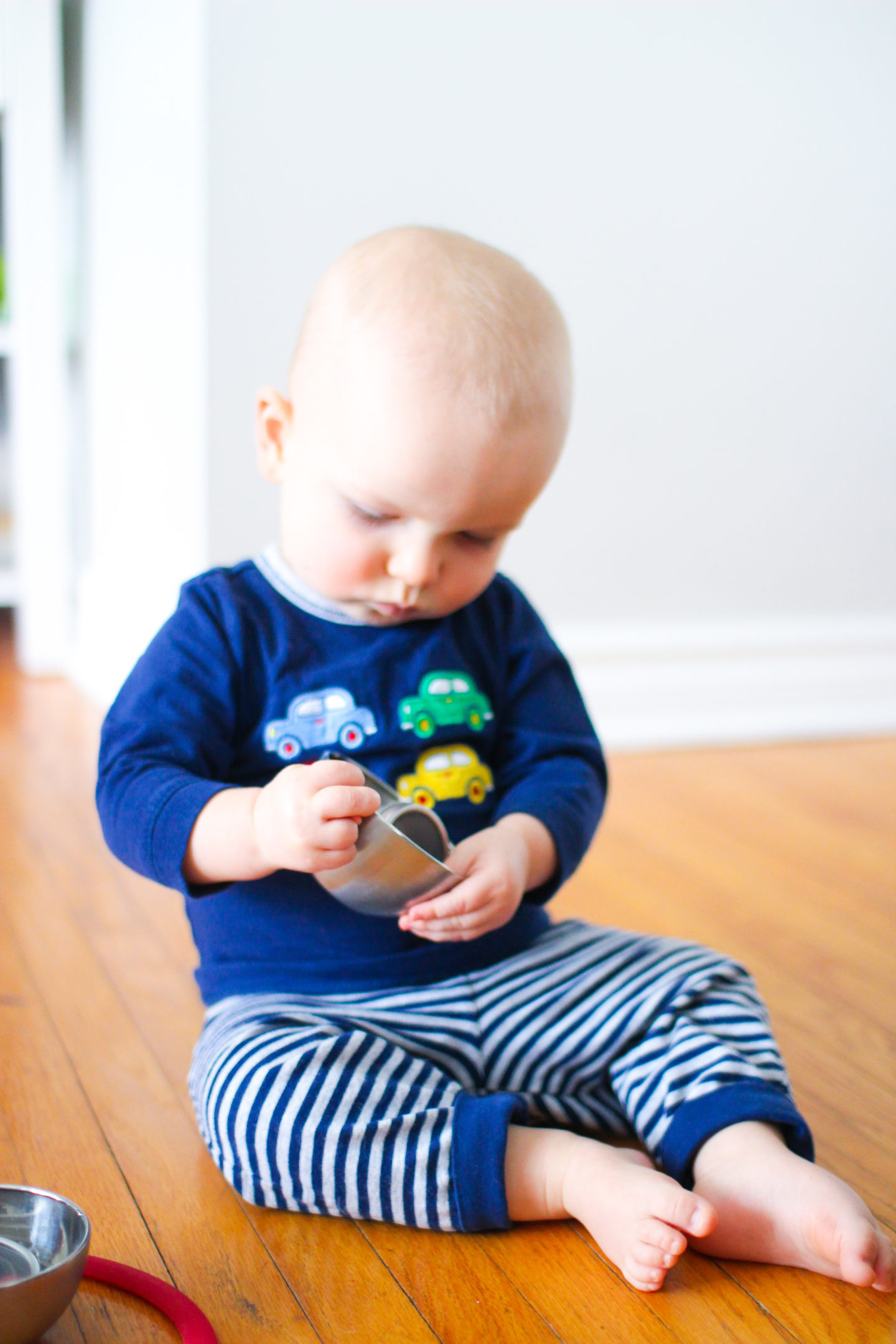
If you’ve ever given your baby toys only to witness them reaching for the coaster on the coffee table a moment later it’s because they’re naturally interested in everyday objects as a way of making sense of their environment. Remember that to baby, everything is new and interesting, even a spatula.
Making a loose parts basket that engages your baby in sensory play is ideal because you’re picking and choosing which everyday objects you’re willing to let baby explore in a safe and supervised way.
WHY SHOULD I INTRODUCE LOOSE PARTS SENSORY PLAY ACTIVITIES TO MY BABY?
In terms of learning, here’s the beautiful thing about this kind of play and why I am such an advocate for it as an educator and parent. It doesn’t get boring. It never gets old. They never tire of it because it’s easy to change up. Sounds magical if you’re a mom to a little one with boundless energy and a need for stimulation. Am I right?
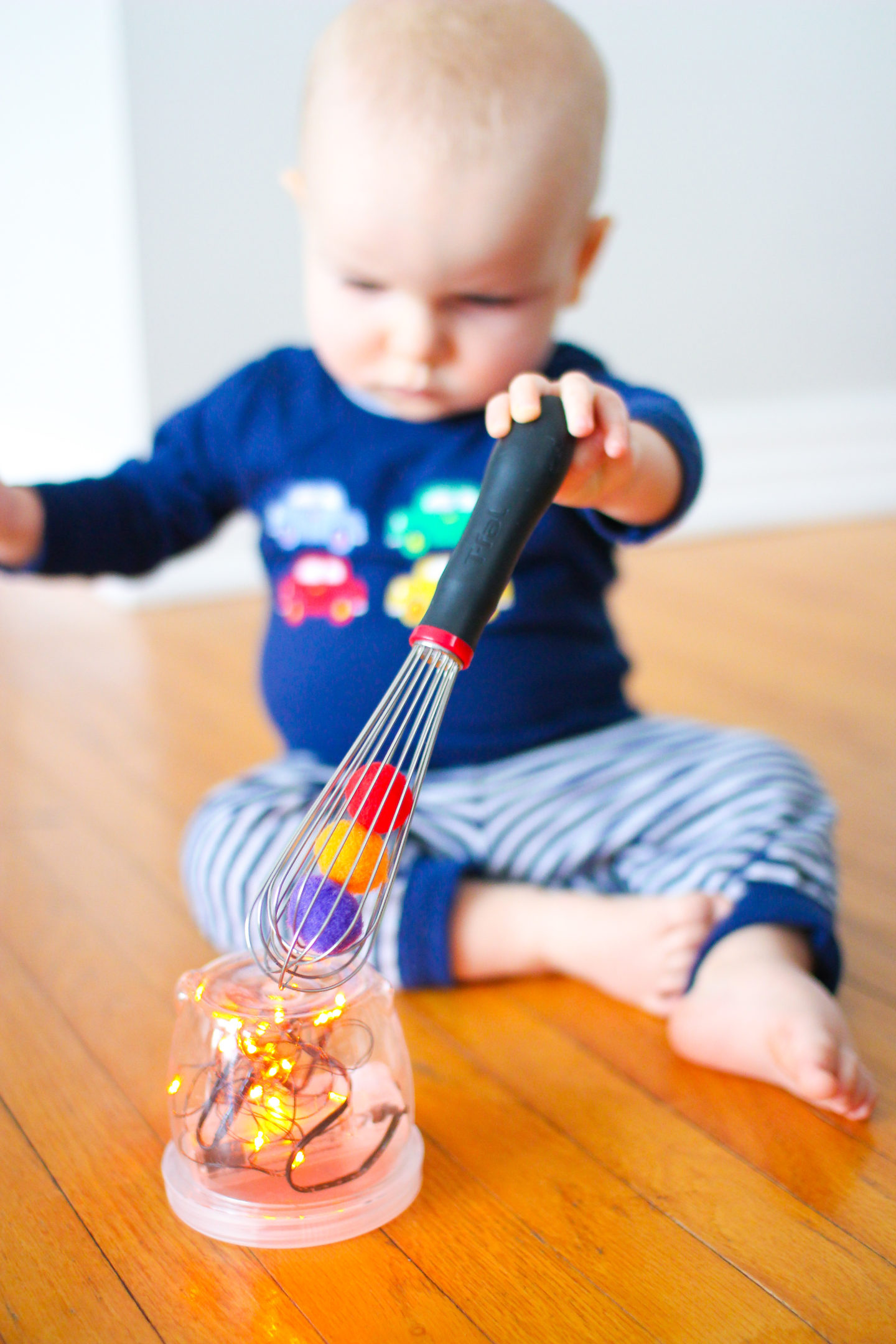
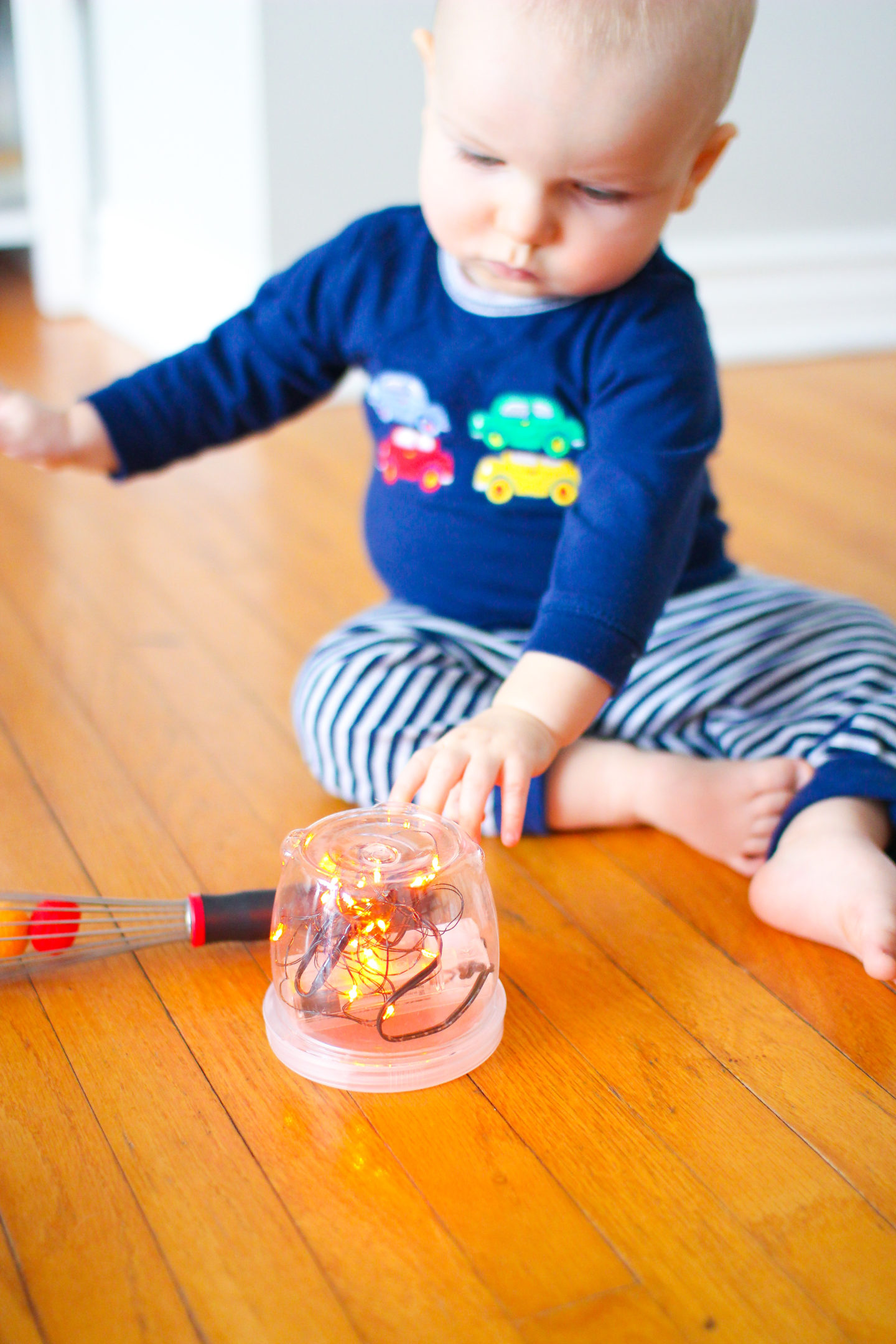
Why is sensory play so magical?
Simply because the items and objects involved are open-ended and do not have a distinct purpose for play. Take a whisk for example. Baby can put his/her fingers in between the loops, can bang it by the handle or by the end (making two completely different sounds), can stick his/her tongue into it, can chew on the end of it, can roll it, can throw it, and can even try to pull pom poms out of it. All this at a few months old! Just wait until they’re older and the very same whisk becomes a magic wand, a scepter, or a guitar.
HOW IS THIS DIFFERENT THAN ELECTRONIC TOYS?
All of this is very different than electronic toys that have buttons and flashing lights. The problem with some of these toys is that they don’t allow for endless possibilities. Once the child masters pressing the button to trigger the light or music, they’re done. They’ll be fascinated by this for some time, and you’ll admire them for their ability to link cause and effect, but it won’t last long. After some time you’ll find that they either ignore the toy entirely or they’re playing with it in some unintended way. They’re trying to take the toy apart or they’re throwing it around. You can’t blame them, they’re bored of it! Pushing a button is only fun as long as it is interesting and challenging. Once it isn’t, that toy just isn’t going to be fun for baby anymore.
The problem with some electronic toys is that they don’t allow for endless possibilities. Once the child masters pressing the button to trigger the light or music, they’re done. If they’re trying to take the toy apart or they’re throwing it around, you can’t blame them, they’re bored of it! Pushing a button is only fun as long as it is interesting and challenging.
Don’t get me wrong, I have some electronic toys too, and Lucas likes them, but I don’t expect he will want to play with them for long. Once he’s figured it out, he’ll toss it aside and search for the next learning opportunity. That’s why you so often see parents selling these once-loved toys online. They have a very limited shelf life.
Electronic toys are fun, but not all of them are effective at encouraging prolonged independent play.
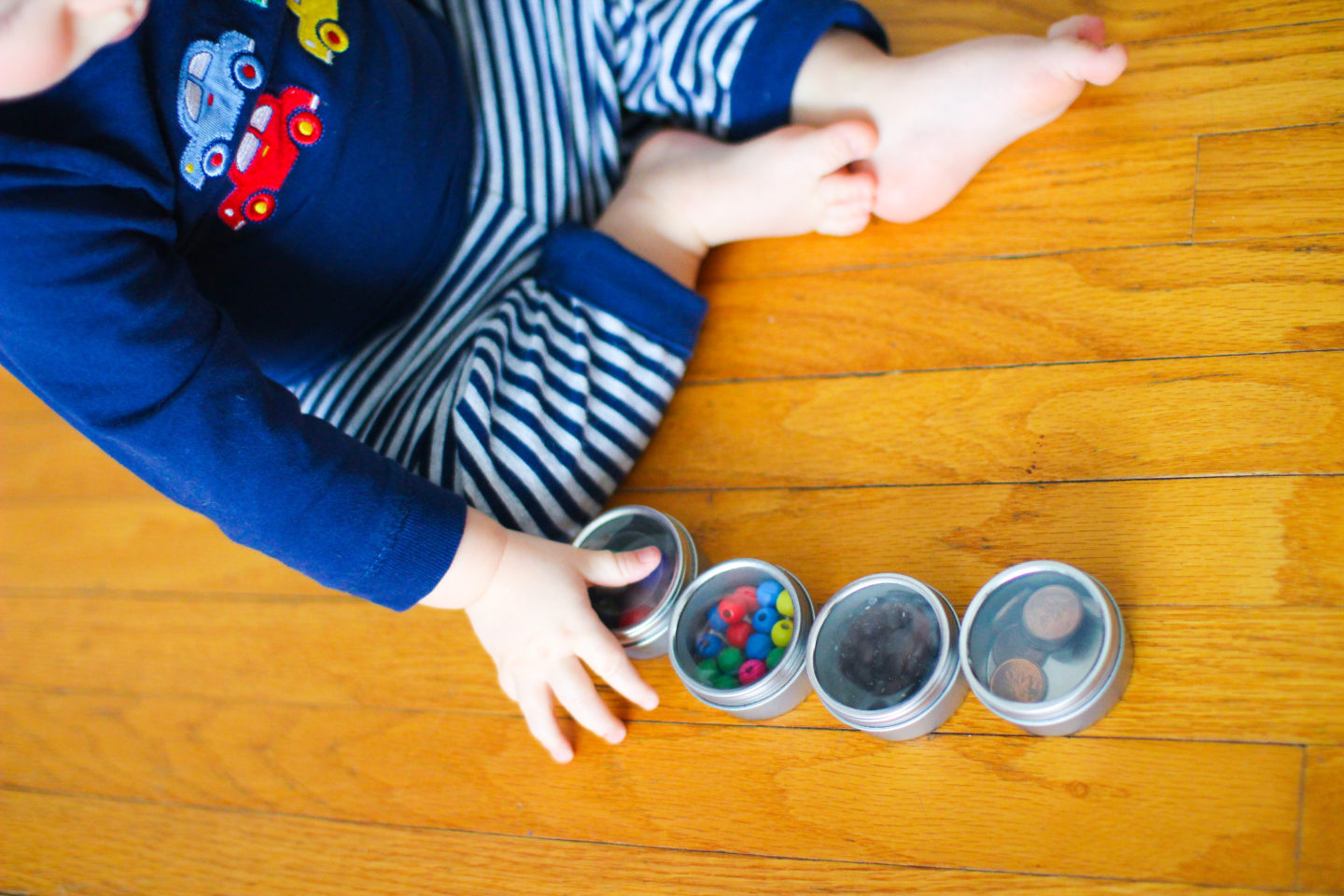
WHICH LOOSE PARTS SENSORY PLAY ITEMS SHOULD I GATHER?
Loose parts sensory play offers unlimited learning opportunities for all children and can easily be adapted depending on age and ability. The materials provided, and how you offer them, is highly age-dependent. If you have an infant who puts everything into their mouths consider how you can house smaller objects that may be a choking hazard so baby can still explore them without concern. I use water bottles, tins, and clear plastic containers for this. For example, pebbles and beads can be placed within a container for infants, but are fine for older children to play with freely.
If you have an infant who puts everything into their mouths, substitute smaller objects that may become a choking hazard with larger items so baby can still joyfully explore and play safetly. Safety should always be your number one concern when setting up a sensory bin or basket.
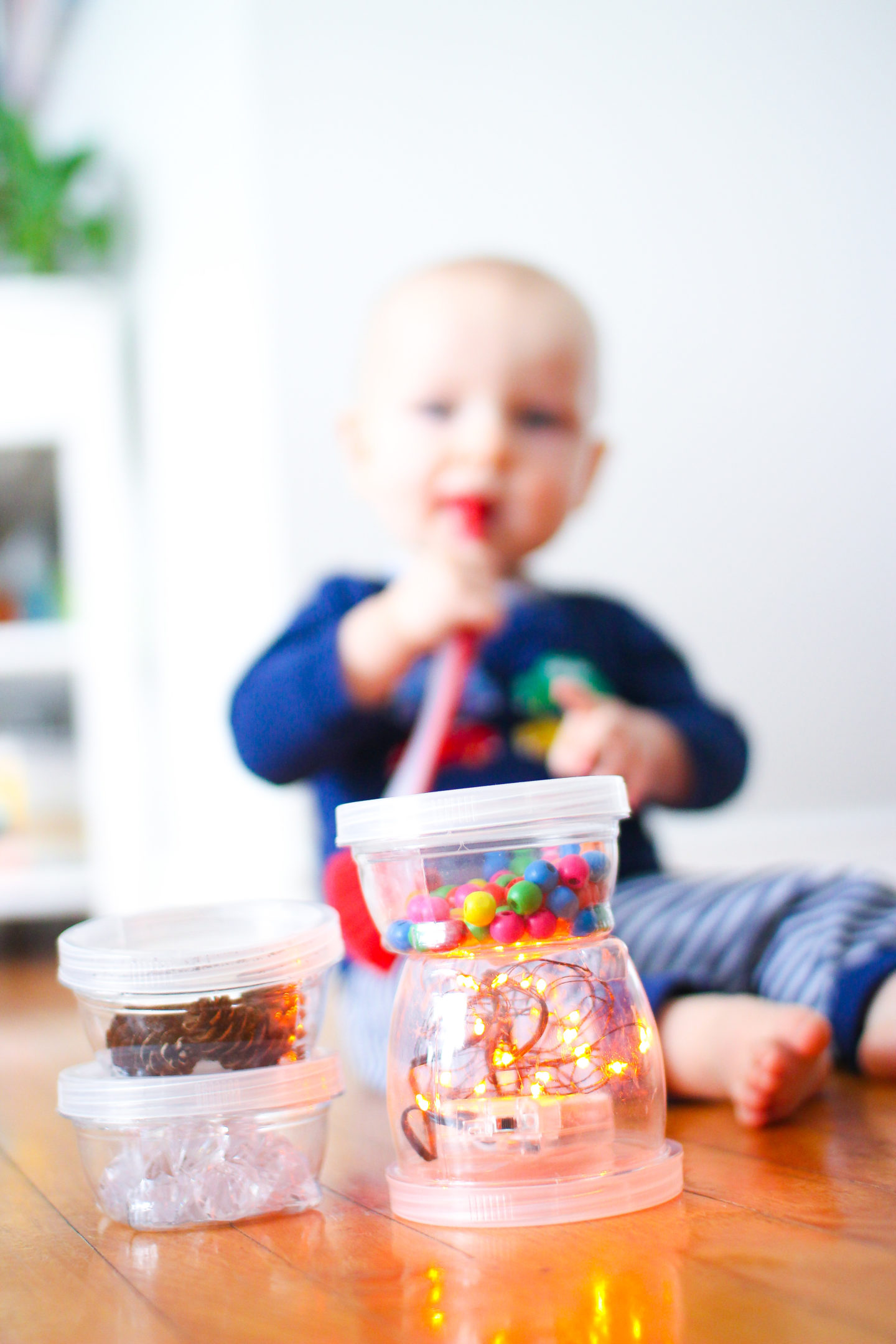
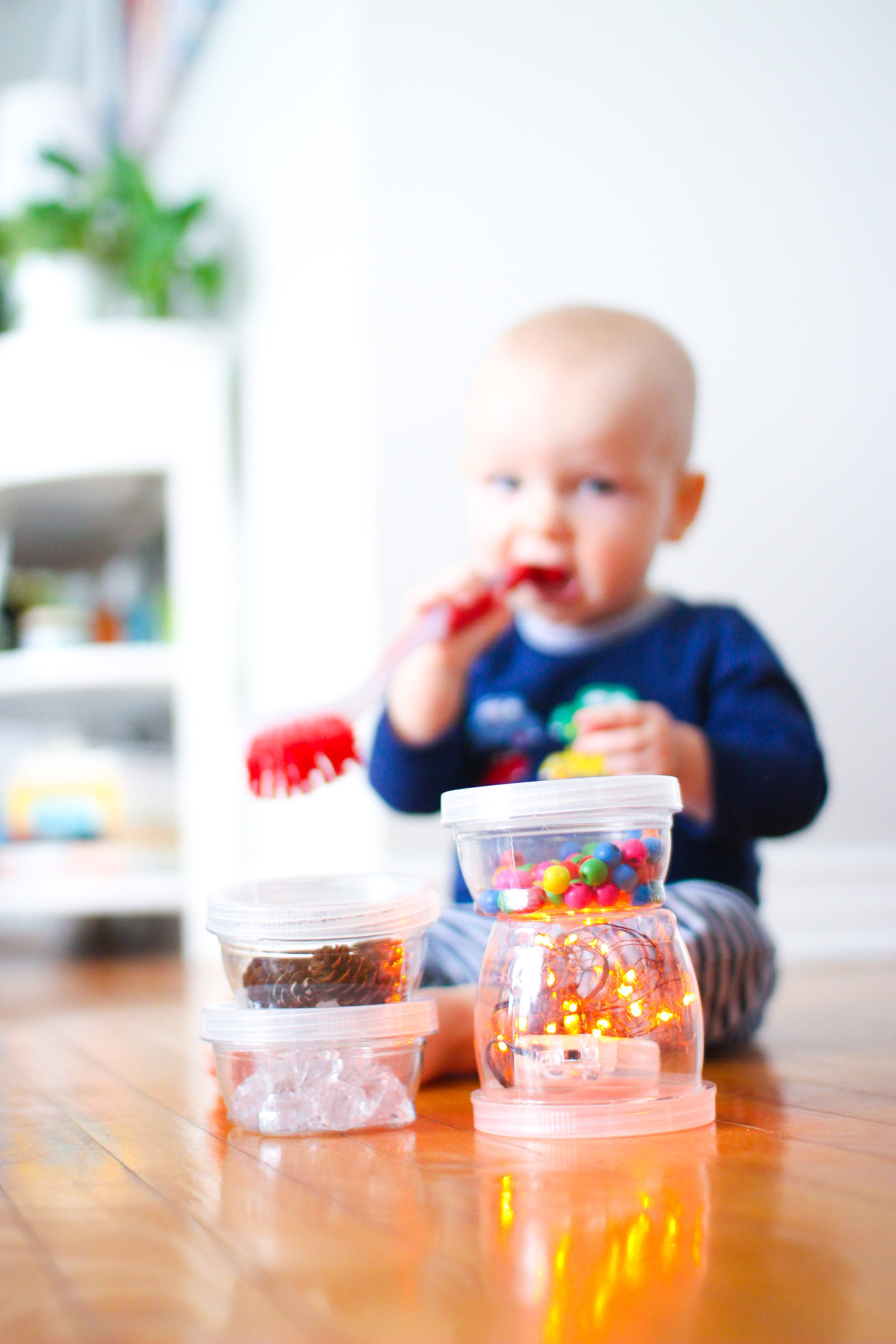
Below you’ll find examples of what’s in my loose parts sensory basket. Some of the things on this list I’m still on the hunt for or am saving for later. But this loose parts material list should provide some ideas for what you can look for at the dollar store, bring out of your kitchen drawers, recycling bin, crafting stash, or gather from outside.
DOLLAR STORE LOOSE PARTS LIST
clear stackable plastic containers -Preferably with screw on lids
small metal or wood bowls
Large colourful beads
tiny string lights
set of measuring spoons (can be held together on a loop)
water beads
lightweight coasters
faux glass hand-held mirror
all types of sensory balls
decorative wooden/wicker balls for a bowl
food coloring
Pipe cleaners (for older kids, little ones can use ribbon)
Velcro hair curlers
Shower clips
GATHERED FROM NATURE LOOSE PARTS LIST
tiny and large pinecones (watch that they don’t eat the big ones!)
shells and coral (depending on where you live, the manufactured kind can be bought at the dollar store)
water (in a bottle with food colouring, water beads, beads, or mixed with oil)
tree cookies
tree chunks/sticks (dependent on age)
pebbles/rocks (dependent on age)
nuts and/or acorns
evergreen pieces (more appropriate for older children unless you contain them)
wine corks
potpourri (if you have a spice container, they could shake it and smell it!)
KITCHEN DRAWER, RECYCLING OR CRAFT BIN ITEMS
toothpicks (remember, these small items should be housed within a container for baby play)
pennies
basting brush
paper towel rolls
boxes and tins (tissue boxes, baby puffs containers)
ribbons of various widths, lengths and colours
napkin rings
small whisk
silicone scrubber brushes
circular silicone hot plate holders
silicone garlic masher
dish scrubber brush (or any kind of soft hair or paintbrush)
ice cube tray
spatula
funnels
disposable water bottles
uncooked rice, beans, macaroni, and corn
sponges
wooden spoons
tissue paper (just make sure they’re crinkling, not eating!)
colander (can stick ribbon or pipe cleaner into the holes)
fabric (different textures and colours)
microfiber mop cloths
bottle lids
plastic Tupperware containers and lids
plastic scraper/dough tools (flat-edged or grooved. My cast iron skillet came with these)
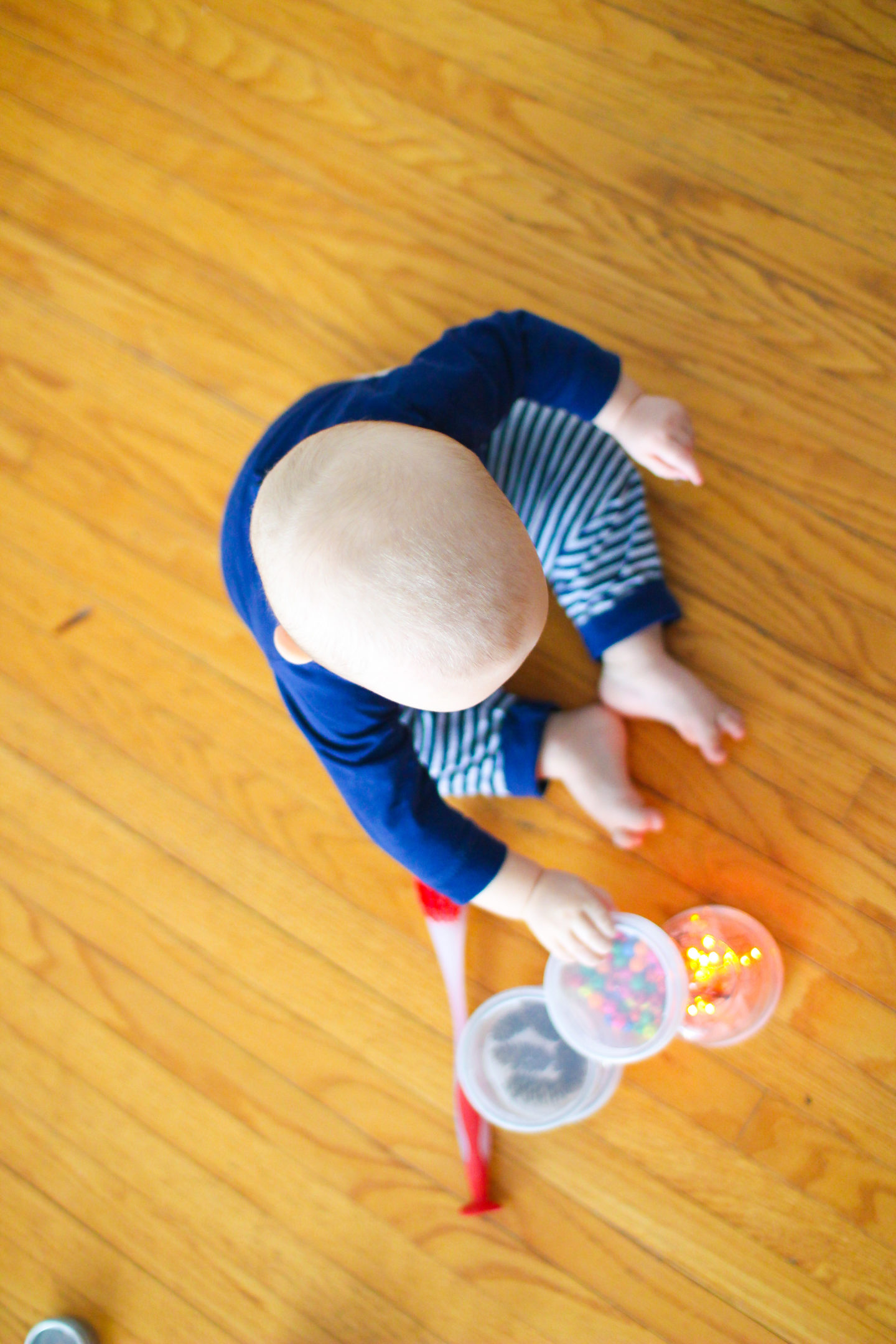
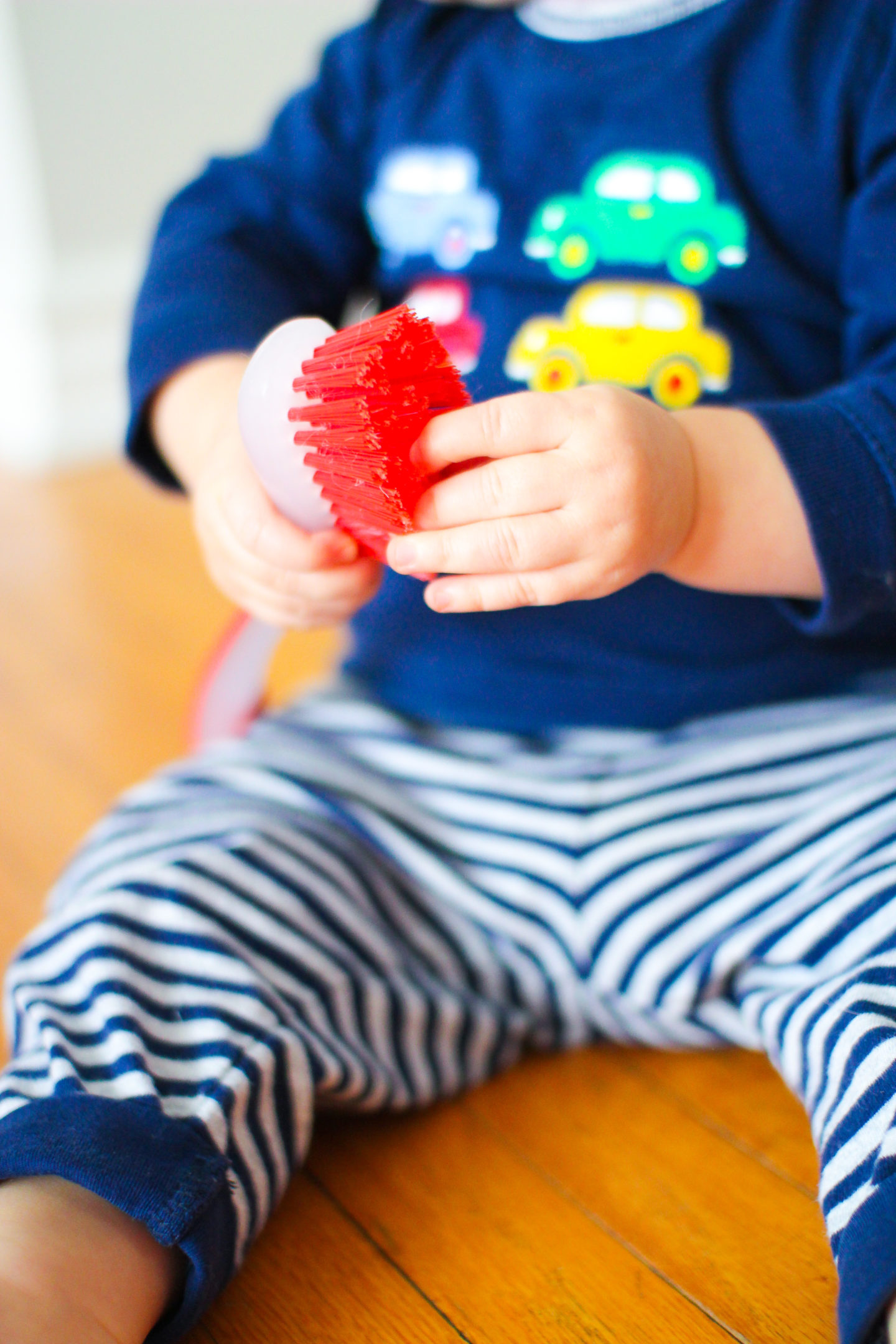
DOWNLOADABLE PDF LOOSE PARTS LIST
A note on safety: of course, since loose parts and sensory items aren’t always manufactured toys you need to make sure you’ve got your safety hat on. Since some of this is from the dollar store it’s not exactly high-quality stuff. Look over the items carefully first ensuring there are no loose parts (ha, get it?) ie. the top of the paintbrush is glued securely to the handle. Make sure bottle and container lids are screwed on tightly and check this regularly. Baby should always be supervised closely when engaging in loose parts play, particularly when first introducing them to the items. Your baby will explore the objects in different ways, and what may be safe one minute can get worrisome the next. For example, when I first gave Lucas a paper towel roll he banged it on everything and yelled into it for some time, which was great! But once he started to eat it, not so much.
HOW DO I INTRODUCE & ENGAGE MY BABY IN SENSORY LOOSE PARTS PLAY?
A little bit at a time! This is a good rule of thumb generally speaking with kids. Show baby only 3-6 items at once. They’re bound to get overstimulated and overwhelmed if they have too many items at a time (this is also true with regular toys).
Provide baby with 3-6 items to play with at a time to avoid overstimulation and keep them focused. You never want to provide your child with too many options (loose parts of otherwise) at a time and should rotate your toys.
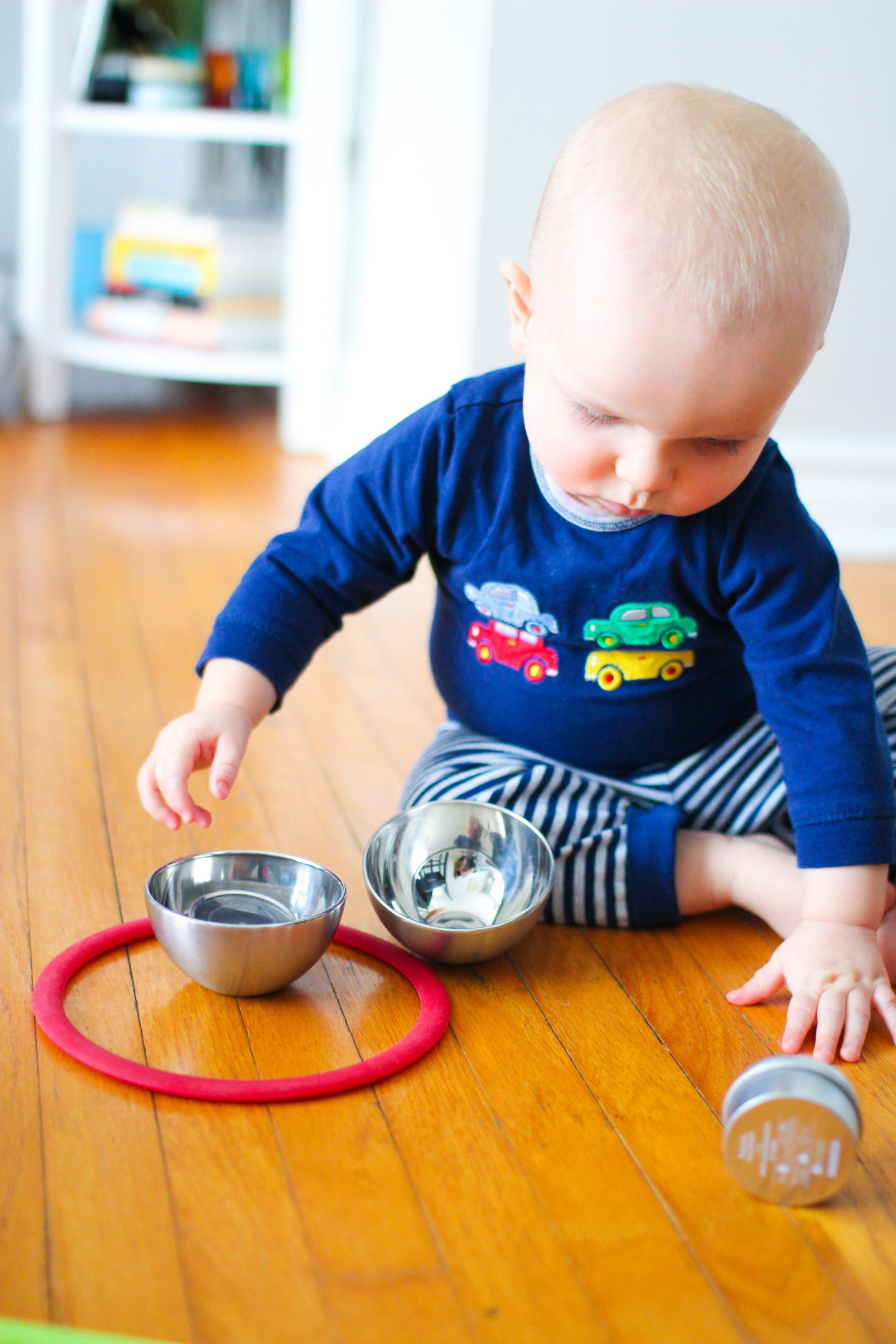
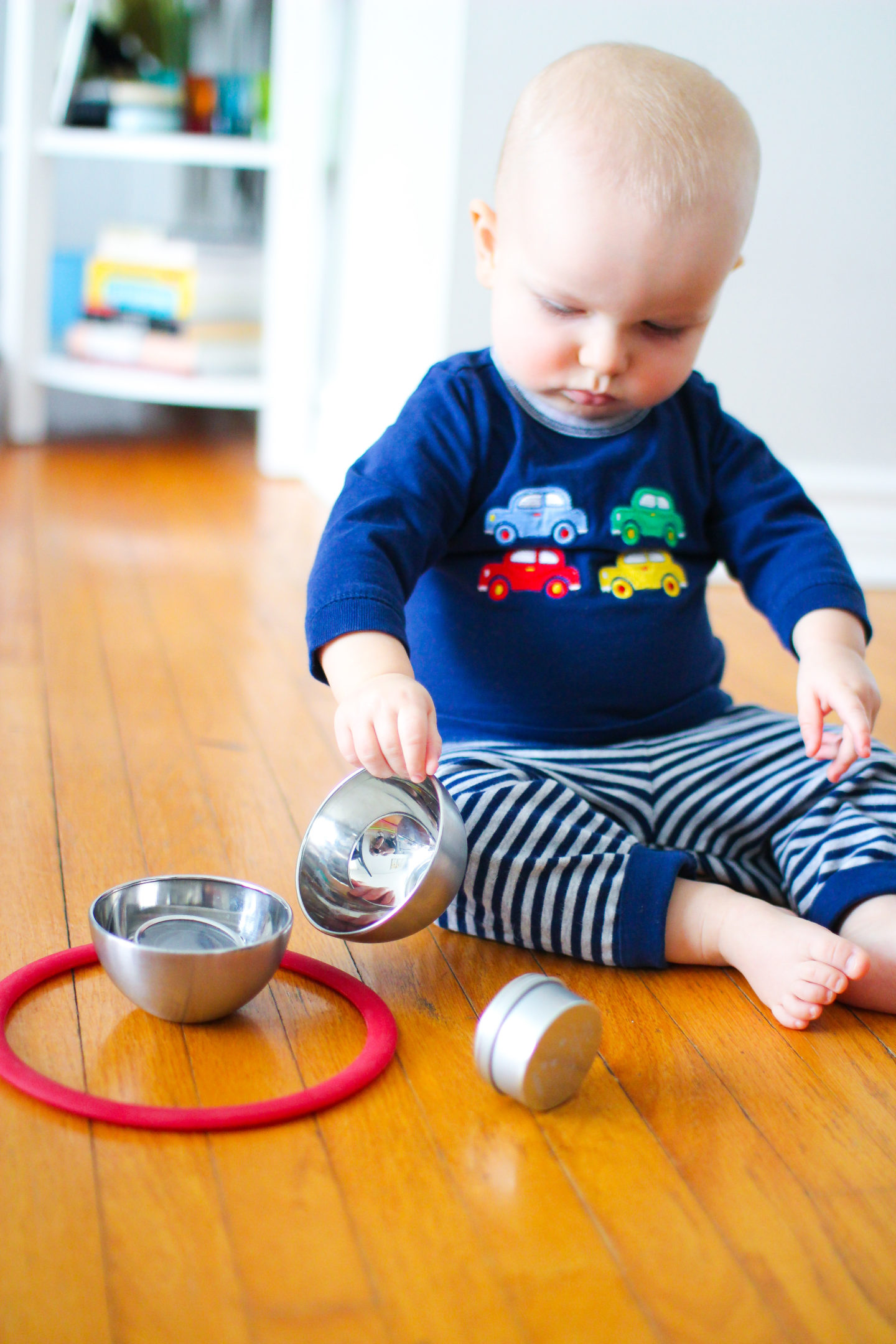
Secondly, as I mentioned above, I don’t have everything on the list physically in my basket. There is no way that would fit! But actually, this is also quite intentional. Mama’s got to keep some things up her sleeve for when things get stale. When I can see it’s time to change things up because they aren’t keeping Lucas’ attention anymore, I’ll swap out some of the items. Keep it simple! Introduce a half-filled bottle of water with added water beads, or take the binder clips out of the clear container and add marbles instead. It’s great to have all of the items on hand so you can do this at a moment’s notice. You can slowly work towards creating your secret loose parts stash (which is what I’m actively doing).
I don’t have everything on the list physically in my basket. There is no way that would fit! But actually, this is also quite intentional. Mama’s got to keep some things up her sleeve for when things get stale. When I can see it’s time to change things up because they aren’t keeping Lucas’ attention anymore, I’ll swap out some of the items.
Don’t forget to play with your baby. Engaging baby in sensory and loose parts play can be tricky, because you may be tempted to show them how to do things, but you also want to let them discover things on their own. Wait for a lull in their play and inspire baby with something new, such as stacking containers, flipping something upside down, or making a sound by banging objects against one another. They’ll often copy you and try to see if they can manipulate the items in the same fashion.
Set up play invitations and encourage exploration by playing together. Stack containers, flip something upside down, or make a sound by banging objects against one another. They’ll often copy you and try to see if they can manipulate the items in the same fashion.
IN THE MEAN TIME TRY A FEW OUTDOOR ACTIVITIES
HIKING OR WALKING OUTSIDE
From just about birth, you can start getting your baby outside to hike or walk with you. Whether they are in the stroller, baby carrier or just in your arms, and whether you are hiking a trail or just walking back and forth in the driveway, getting outside and moving is a beneficial experience for you and your little one.
TUMMY TIME, READING OR PLAYING OUTSIDE
Bring your normal inside activities outside to the fresh air. Grab a blanket and some books or toys and take playtime outside instead of inside. Even just napping or nursing your infant outside can feel like a new experience.
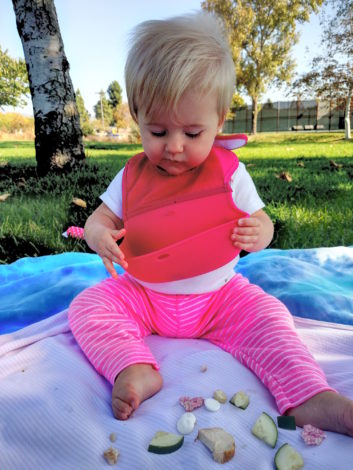
PICNICS
What a better place to start your baby on new foods then outside? Sit them on a blanket and picnic together while they try out new foods and new ways of feeding themselves. Added bonus: cleanup for you doesn’t involve scrubbing floors, walls, windows or high chairs. If they still need support when sitting, try a “bumbo” type seat with a tray or just bring their high chair out with you.
SENSORY PLAY
One of the key elements for development in babies is sensory play and the outdoors is filled with new things to explore and stimulate their senses. Let them crawl around in new terrains – grass, dirt, sand, leaves, etc. Let them pick up new materials – rocks, sticks, sand or mud. Just keep a careful eye to make sure their new finds don’t turn into their next picnic.
GET DIRTY
Don’t be afraid to let them get dirty! Let them squish the mud or scoot through the dirt or roll around in the grass. If you don’t want to rush to the bath tub afterwards, then move right on to one of the next activities below…
WATER PLAY
You can take them to a pool or body of water and take them in the water with you, or fill a few bowls with water and let them splash around with their hands. Don’t overthink it – babies thrive on simplicity.
PLAYGROUNDS
During off hours, when there are not many bigger kids around, playgrounds can be perfect places for babies to work on new large motor skills, such as crawling on new surfaces, pulling up and climbing.
BUBBLES
Babies love bubbles. They are easy and cheap (if you are ambitious, you can make your own following this recipe) and you are sure to get some giggles!
BALLS
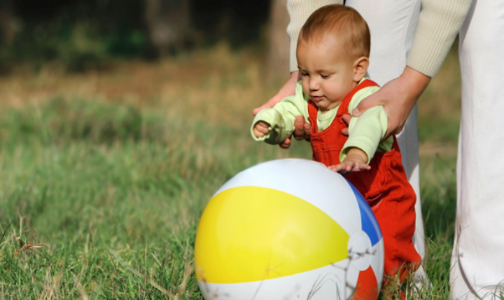
One of the best toys for little ones are different sized balls for them to push around and watch bounce. Outside is the perfect place because there is nothing to hit and plenty of space. Feel free to experiment with different size balls. This will help with both gross and fine motor control.
WALKING PRACTICE
Once your little one starts trying to walk, bring them outside where there are less sharp edges and lots of softer surfaces for the inevitable spills. The only downside is that they may become more interested in a new discovery on the ground and may not get very far!

Superscript
THINGS TO DO OUTSIDE WITH ITTY BABY
Timing is everything so avoid being outside for the hotter parts of the day.
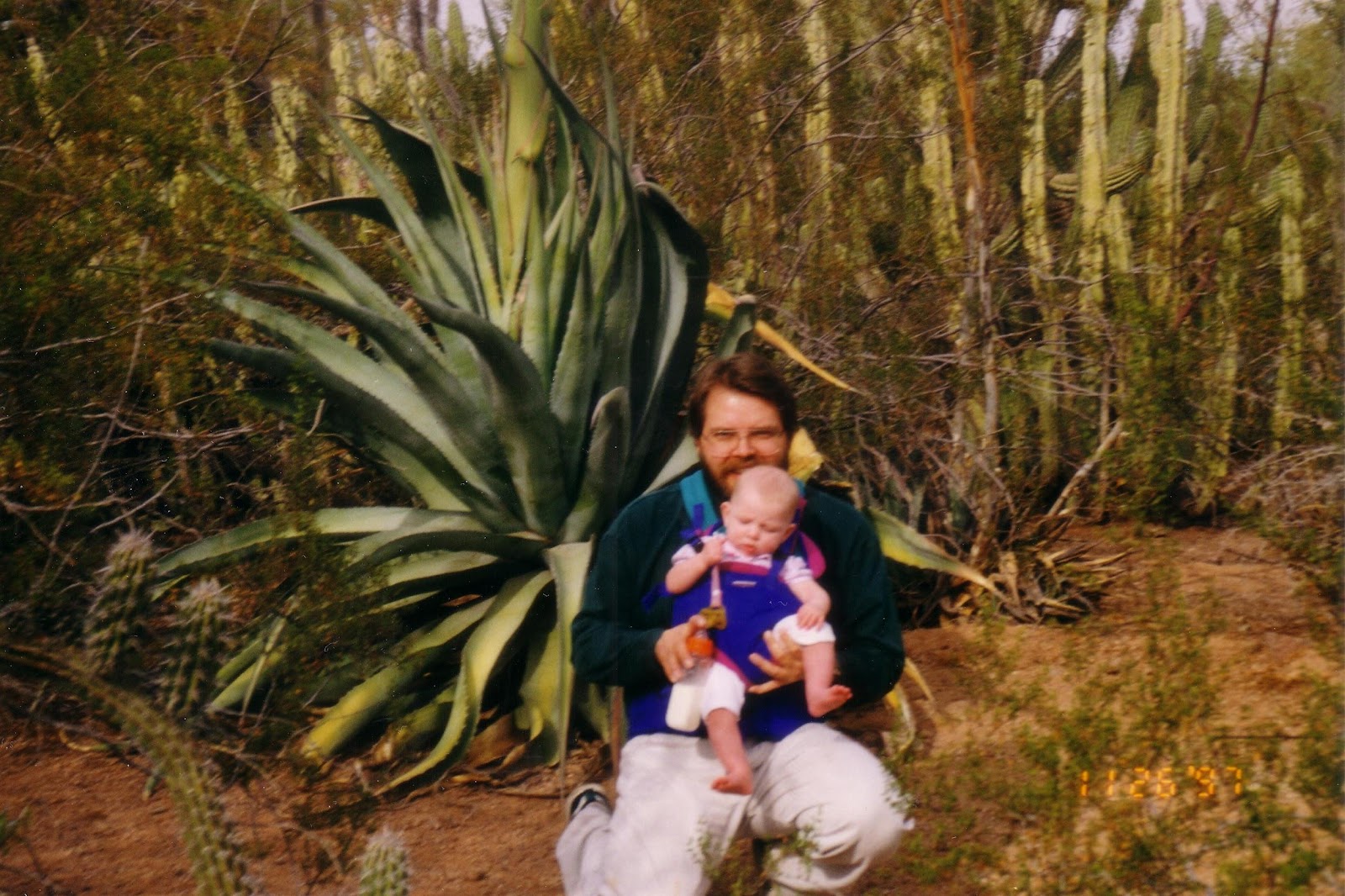
the Amazing Benefits of Sunlight for Newborn Babies
In this Article
Health Benefits of Sunlight for a Newborn
Tips to Gain Maximum Benefits From Sunlight for your Baby
A newborn baby’s sensitive skin needs to be protected from the harmful effects of the sun, including heat and moisture. Keeping your baby away from direct sunlight is a good idea, but exposing your little one to mild sunlight – especially in the morning – is beneficial in many ways. UV rays come with great health benefits when properly made use of for the baby.
Amazing Benefits of Mild Morning Sunlight for Newborn Babies
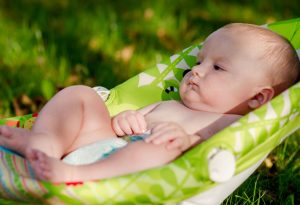
1. More Vitamin D:
This is one of the biggest benefits your baby will get on exposure to sunlight. Our body needs vitamin D; and to create it, the body requires a minimum of 15 minutes of UV rays every day, depending on the baby’s skin tone – darker-skinned babies require more time in the sun, but it should not exceed 30 minutes. Vitamin D aids in absorbing calcium, which in turn strengthens bones and teeth. The immune system works efficiently, and the body is protected from diseases.
2. Better Serotonin Levels:
Sunlight is known to augment the production of serotonin when babies receive it in the necessary quantity. Serotonin, which is often called the ‘happy hormone’, boosts the feeling of happiness and security. Serotonin regulates sleep and digestion in babies.
ADVERTISEMENT
3. Enhanced Insulin Levels:
Receiving sunlight from an early age can help prevent conditions like diabetes to a certain extent. Though it is not the only facilitator of good insulin levels, it is definitely an added advantage as the vitamin D in the body helps manage insulin levels. A healthy diet and exercise during the child’s growing years can be extremely beneficial in keeping diabetes in check.
4. Manages Jaundice or Yellowing of the Skin:
Sunlight helps break down bilirubin – a yellowish compound that occurs in the natural catabolic pathway – so that a baby’s liver can process it more easily. The unchecked growth of bilirubin can cause the yellowing of a newborn baby’s skin. Exposing your baby to morning sunlight for 15 to 20 minutes, undressed, every day, can help with mild jaundice. A severe case, however, will need more attention.
5. Higher Energy Levels:
When a newborn baby is exposed to natural sunlight, it helps regulate the production of melatonin. Melatonin levels in the baby can impact his sleep patterns, which are of utmost importance in the newborn’s early years. Sunlight causes a dip in melatonin levels and increases serotonin, thus increasing energy levels.
Tips to Gain Maximum Benefits From Sunlight for your Baby
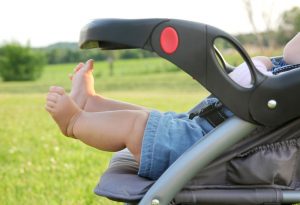
A 2017 study conducted by University College of Medical Sciences, New Delhi showed that exposing babies regularly to sunlight has the ability to give them sufficient vitamin D levels to keep them healthy. The study found that exposing a baby as young as 6 weeks for around 30 minutes a week can give him adequate vitamin D levels to aid in his optimal growth and development. Research also suggests that exposing even 40% of the baby’s body to sunlight can do the trick. However, interestingly, the study showed that the ideal time for a sunbath for the baby is between 10 am and 3 pm! Ours is a tropical country, so sunlight is aplenty – if you live in a fairly cooler climate, the above-mentioned time can be considered. However, if you live in a place that is generally warm, consider the more popularly accepted timings of 7 am to 10 am to expose your little one to sunlight. Just remember this simple rule of thumb: The larger the surface area of the body exposed, the better it is for your baby.
Now that you know newborns and sunlight share a therapeutic relationship, here are a few tips to maximize its benefits:
1. Pick the Right Time:
Make sure your baby is exposed to sunlight for 10 to 15 minutes between 7 and 10 am to draw maximum benefits. An hour after sunrise and an hour prior to sunset is considered the best time to expose your baby to sunlight. Since the baby’s skin is sensitive, exposure to sunlight should not exceed 30 minutes. Prolonged exposure to UV rays can damage your baby’s skin membrane, causing redness, burning, and irritation.
2. Use Minimum Clothing:
It is important that the baby’s entire body, including the chest and back, receives equal attention. So, ensure that your child isn’t fully clothed. Shield your little one’s eyes if possible to avoid any chances of damage.
3. Choose the Right Location:
It is not necessary that your baby’s sunbathing is carried out in a completely open space. Open a window that can stream sunlight in, or place the baby in the room with natural sunlight. If it is windy, it is best to keep the baby indoors to avoid dust or other foreign bodies from affecting his eyes. Your baby can bask in the sunlight through a clear glass window just as well.
ADVERTISEMENT
4. Premature Babies Need Attention:
In case your baby is premature, do not expose him to sunlight during the initial few weeks. The baby may not be able to adjust to the warm temperature, and this could prove unsafe for him. Preterm babies need a stable body temperature, and thus should be kept away from direct sunlight in the initial period. Babies within a healthy weight range can be placed near a clear window.
5. Sensitive Skin Needs Care:
If your baby has sensitive skin, check with your doctor if it is ok to expose him to direct sunlight. Otherwise, you may damage the baby’s skin as it could dry the skin, leading to rashes, peeling or general irritation.
6. There Are No Age Barriers to Sunbathing:
Did you know the process of bone formation happens until one’s teenage years? Since vitamin D is vital for bone formation, exposure to sunlight is mandatory at all ages. For newborn babies, it helps in managing bilirubin levels if it is done in the first few weeks. Remember that you also need vitamin D as much as your baby does, so don’t hesitate to expose yourself to sunlight when doing so with your baby!
7. Pre-Bath Cleaning Can Be Detailed:
Your baby can receive his daily dose of sunlight before he has his bath. This will help you to clean areas that are overlooked, like the folds of the stomach, thighs, feet, and areas behind the ears.
8. Watch Body Temperature:
Any abnormal increase in the baby’s body temperature due to prolonged exposure to sunlight should be a cause for concern. The baby’s body and brain function can be affected by high temperatures, so the duration and temperature have to be monitored carefully.
9. Use Time Wisely:
While your baby is enjoying his time in the soft sunlight, you can use this opportunity to connect with the baby. You can massage the baby lightly with baby oil to give him additional protection against skin problems. Caressing the baby creates a feeling of security and warmth, and promotes good health. Make sure you speak to the baby the entire time and build a foundation for future communication between you and him. This well-utilised time has many physical and emotional benefits for both, the baby and the mother.
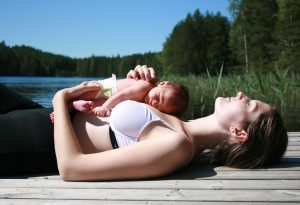
Now that you understand the powerful physical and emotional benefits of sunlight exposure for your little one, it is time to take action! You will have to consider your baby’s skin condition and general health before you do so. Make sure you join your baby for this glorious exercise whenever possible. Sunlight is available in abundance for most of us, and we should utilise it to the maximum for health-related benefits.
Nature Walks- whether you wear your baby, carry your baby, put your baby in a stroller the fresh air will be beneficial to both of you.
Naps
Picnics
Day 1Enter your date |
|
10am First sessionSpeaker name |
|
12pm LunchCoffee and cookies |
|
1pm Second sessionSpeaker name |
|
3pm Third sessionSpeaker name |
|
5pm Fourth sessionSpeaker name |
Day 1Enter your date |
|
10am First sessionSpeaker name |
|
12pm LunchCoffee and cookies |
|
1pm Second sessionSpeaker name |
|
3pm Third sessionSpeaker name |
|
5pm Fourth sessionSpeaker name |

